MYCO 4.1C,D,E | Fungal Mutualisms pt. 2, Fungal Plant Pathogens & Invertebrate Parasites
1/102
There's no tags or description
Looks like no tags are added yet.
Name | Mastery | Learn | Test | Matching | Spaced |
|---|
No study sessions yet.
103 Terms
_ is a model of animal-fungus mutualism
Sirex wasp association with a basidiomycete (Amylostereum areolatum)
In Sirex wood wasp-basidiomycete mutualism, the fungus benefits from _, while wood wasp benefits from _
Fungus benefits from dispersal & distribution into lignocellulosic substrates by wood wasp
Wood wasp benefits from fungal-induced rotting, feeding on fungi and their wood breakdown products
Explain wood wasp-basidiomycete animal symbiosis
Sirex wood wasp association with basidiomycete (Amylostereum areolatum) is a model of animal-fungus mutualism
Fungus benefits from dispersal & distribution into lignocellulosic substrates; wood wasp benefits from fungal-induced rotting, feeding on fungi & their wood breakdown products
(A) Female adult wasp carries (B) asexually produced fungal arthrospores (oidia) in (C) internal mycangia near base of ovipositor
(D) Longest part of life cycle of wood wasp is spent in host tree; larvae burrow thru the wood, which is being decayed by symbiotic fungus (white rot) and pupates under the bark
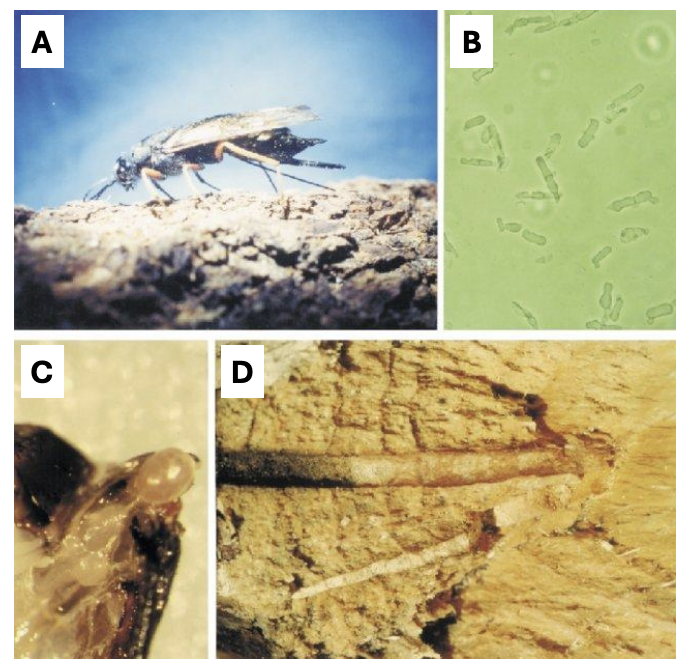
T/F: Longest part of sirex wasp life cycle is spent inside the host tree, where larvae burrow through wood being decayed by symbiotic fungus and pupates under bark
TRUE
T/F: The fungal arthrospores (oidia) being carried by female adult wasps into lignocellulosic substrates are sexually produced
FALSE
The fungal arthrospores (oidia) being carried by female adult wasps into lignocellulosic substrates are asexually produced
Several insects and arthropods have co-evolved with fungi in mutualistic associations, including _
Leaf-cutting Attine ants
Fungi = gain nutrient source from leaves provided for by ants, secure habitat & dispersal
Ants = feed on living hyphae (bromatia), use fungal enzymes to feed on plant sap
Fungi-herding termites
Fungi = gain nutrient source from wood provided for by termites, secure habitat & dispersal
Termites = no cellulosic enzymes; eat wood enzymatically digested by fungi
Ambrosia fungi + beetles
Fungi = gain nutrient source from wood provided for by beetles, secure habitat & dispersal
Beetles = eat wood enzymatically digested by fungi
*Most are obligate
Common = fungus provides mechanism by which arthropods are fed in some way (fungus itself is eaten or their degraded products); arthropods allow mechanism for secure environment + dispersal + nutrient source
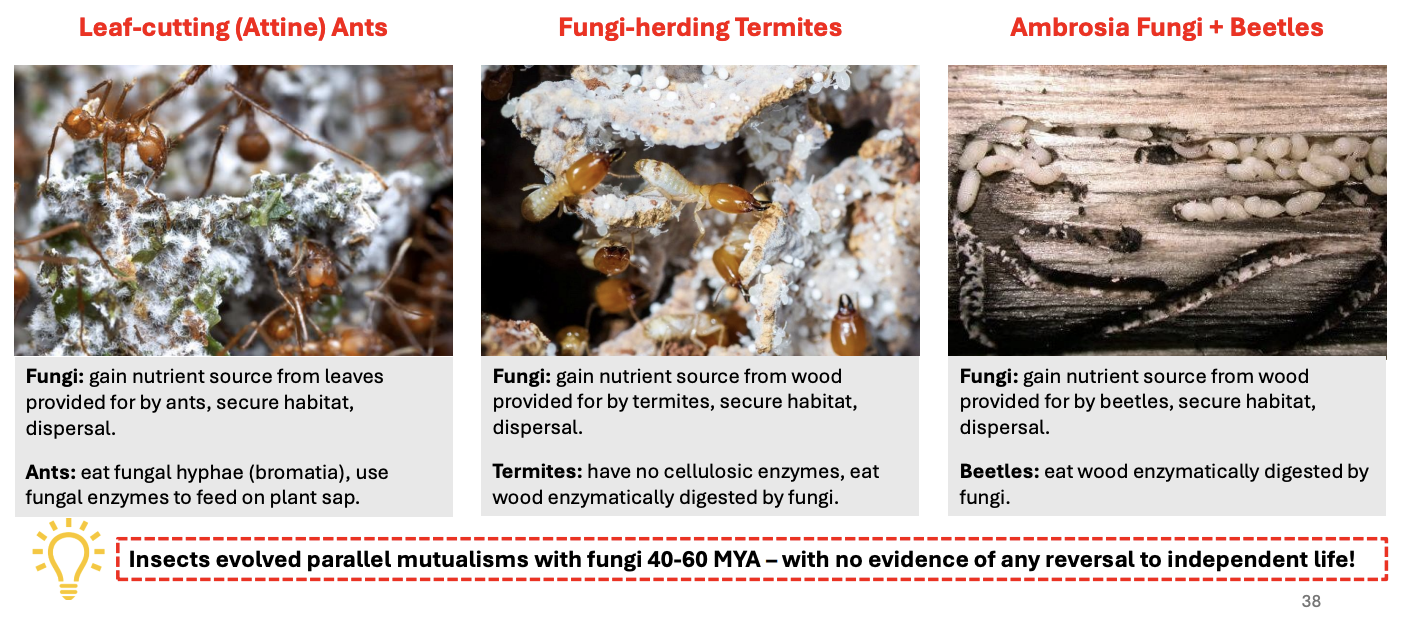
Insects evolved parallel mutualisms with fungi _ MYA—with no evidence for any reversal to independent life
40-60 MYA
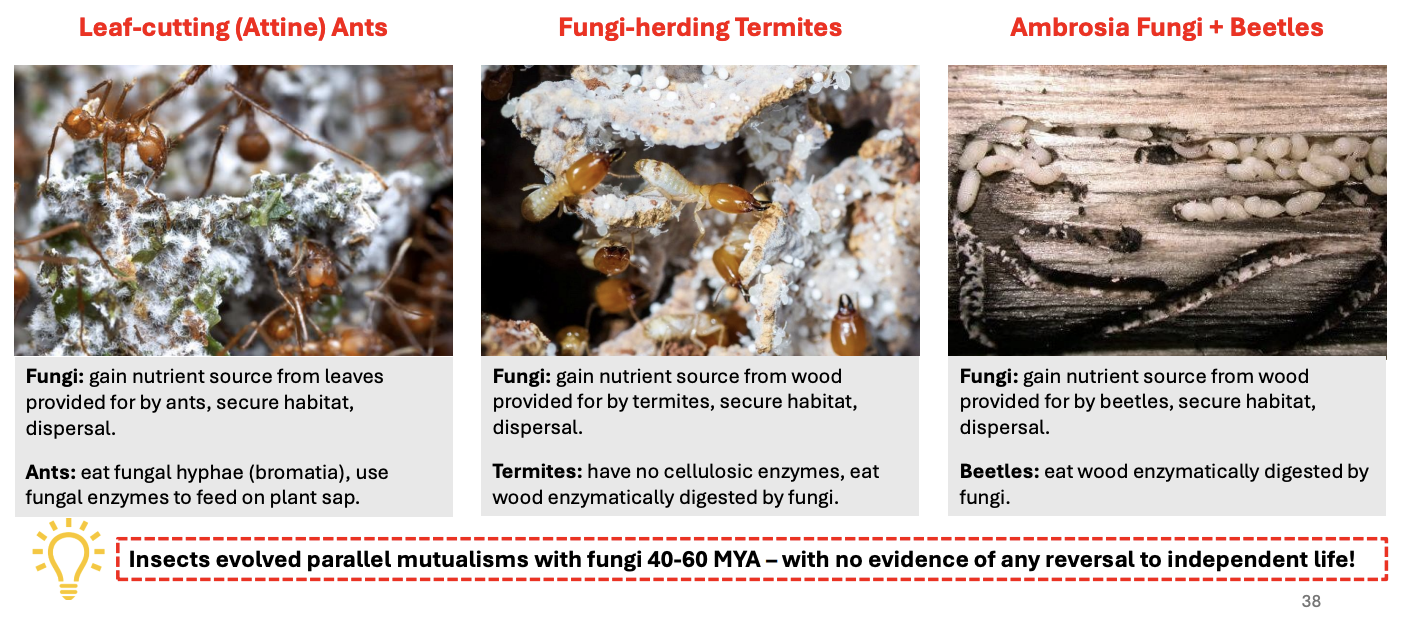
T/F: The female Sirex wasp injects fungal spores directly into host tree roots, where white rot begins decaying the lignin-rich phloem tissue
FALSE
The fungal arthrospores (oidia) are injected into wood tissue, not roots, and they decay lignocellulosic xylem, not phloem
T/F: The longest part of the Sirex wasp’s life cycle is spent inside the host tree, where larvae rely on fungal white rot to pre-digest wood
TRUE
The larval stage is longest, and larvae rely on the fungus to soften/decay the wood (white rot), making it digestible
T/F: Termites evolved to depend on fungi because they lost their own genes for cellulase production
TRUE
The termites lack cellulases, so they rely entirely on fungal digestion of wood
T/F: Fungi associated with termites and beetles both benefit from secure habitats, nutrient input, and dispersal — similar to the benefits received by the Sirex symbiont fungus
TRUE
In all cases (Sirex, termites, beetles), fungi receive wood substrates, shelter, and insect-aided dispersal
_ is a term used to describe the actively farmed fungal communities maintained by leaf-cutting attine ants, termites, wood-boring beetles bc they choose the fungi, provide them food, maintain optimal growth conditions, then harvest fungi to eat
Fungus garden
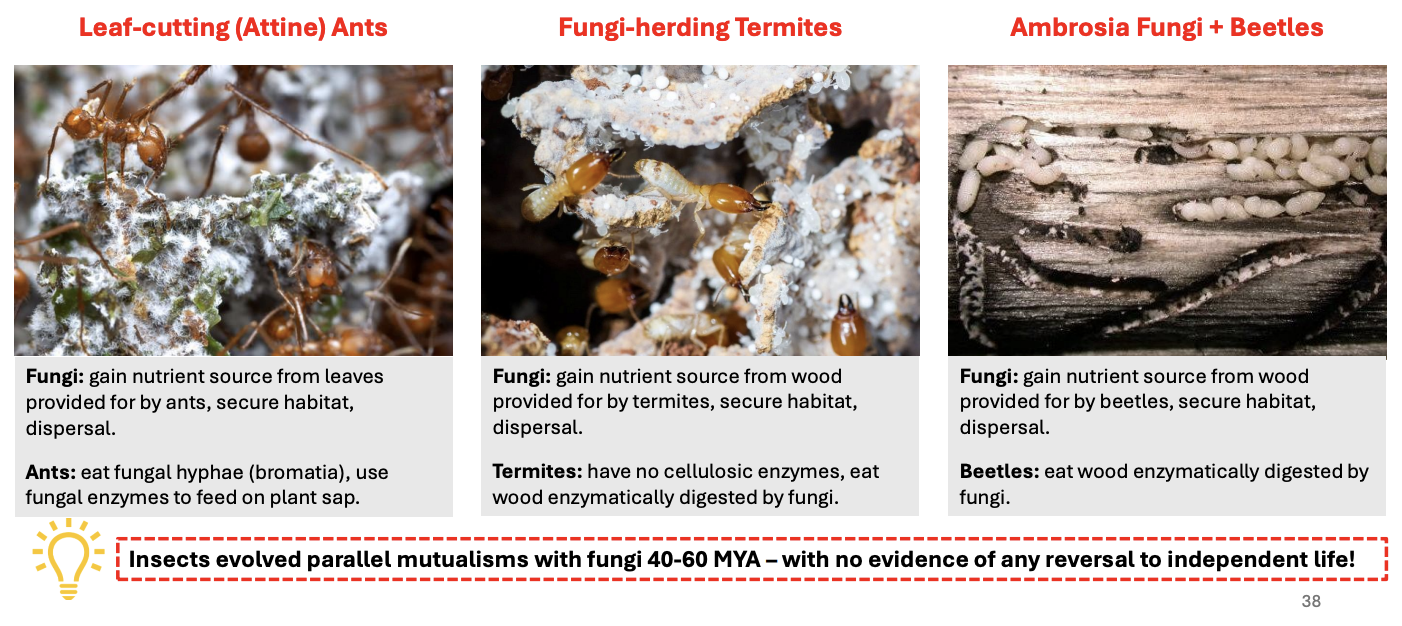
Why are lichens indicator of good air quality?
Because increased levels of pollutants or poor air quality can cause the dissociation of symbiosis or lichens may not form to begin with
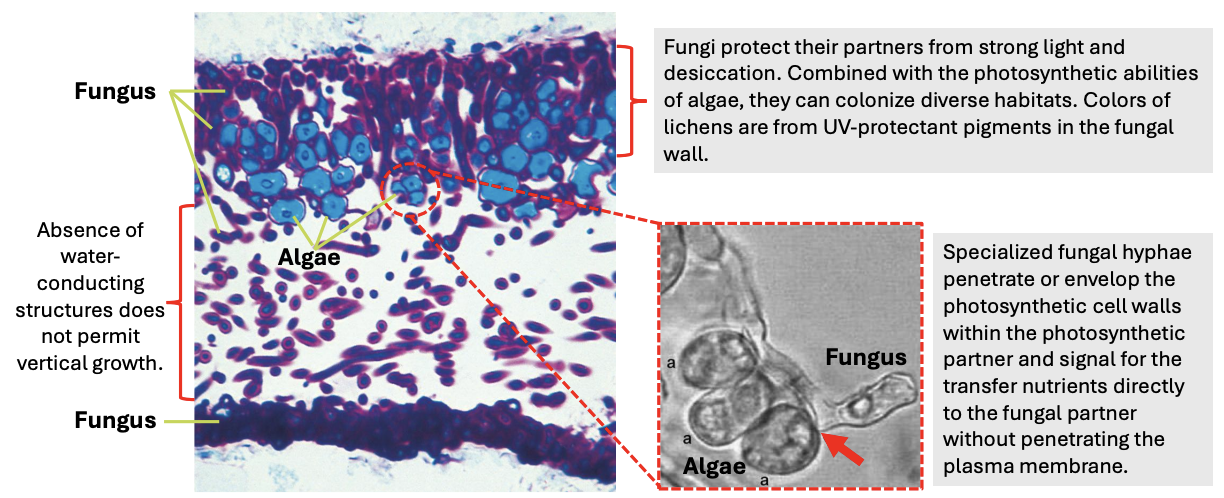
T/F: Fungi can act as pathogens and parasites against many organisms
TRUE
Parasites vs. Pathogens
Parasites = an organism that gains part or all of its nutritional requirements from another organism (host)
Pathogen = an organism that causes disease after infection
Most pathogens are parasites, but not all parasites are pathogens
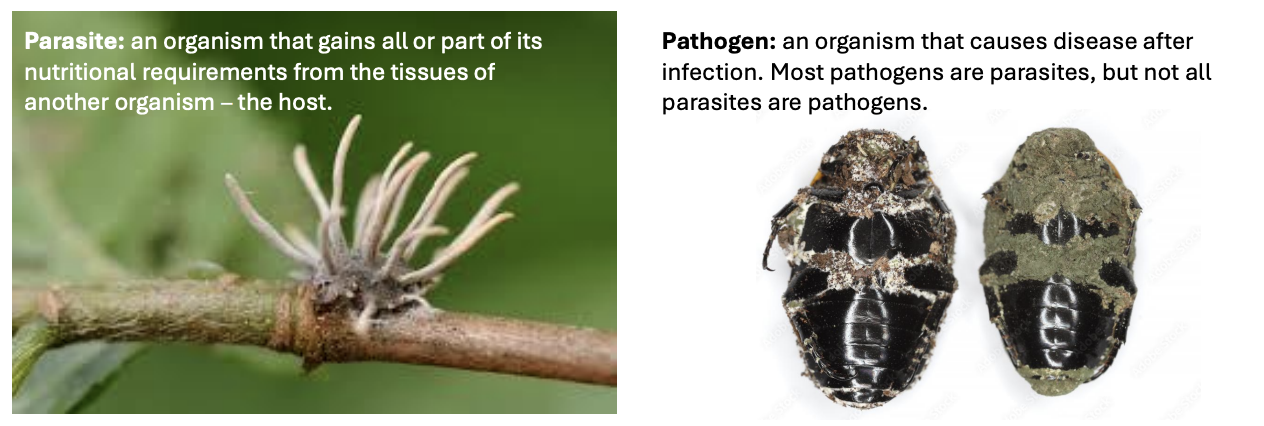
Describe different types of parasites & pathogens
Parasites
Necrotrophic = kill host tissues thru invasion or by producing toxins or degradative enzymes itd; feed on tissues they kill
kill before eat
Biotrophic = feed on living host tissues, usually by producing special nutrient-absorbing structure snas that tap into host tissues
eat while alive
Pathogens
Non-specialized = have broad host range, usually attack immature or dying tissues, or organisms whose resistance is compromised by other (i.e., environmental) factors
broad-range infective structures
Host-specialized = narrow host range, can adapt to specific defense systems to ward off infection
can only infect group of organisms usually related
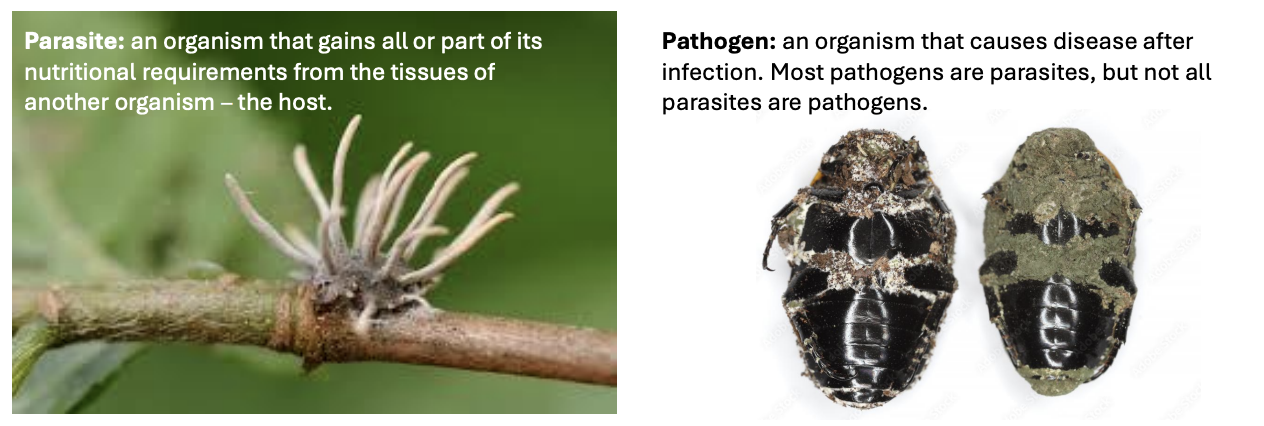
T/F: Biotrophic pathogens are typically non-specialized because they don’t harm their host
FALSE
Most biotrophs are host-specialized — they need to evade the host’s specific immune responses to keep feeding without killing
Enumerate 8 examples of necrotrophic fungal plant pathogens/parasites
sds fvs mp
Seed + seedling rots
Decline + replant disease
Stalk rot pathogens
Fruit rot fungi
Vessel wilt disease (Fusarium,Verticillium)
Smut fungi
Mycotoxic endophytes
Phytophthora
A characteristic range of fungi (e.g., Pythium, Rhizoctonia solani, Fusarium spp.) cause seed rots or seedling diseases associated with _
wet soil conditions in young plant tissues

All these fungi (e.g., Pythium, Rhizoctonia solani, Fusarium spp.) respond rapidly to presence of seed or seedling exudates and invade _
To counteract this problem, _
Young tissues with little inherent host resistance
Seeds are usually coated with natural broad-spectrum fungicides produced by plants

Explain necrotrophic seed + seedling rots
There are more fungi in soil than in air, making plant roots an easy area to access to fungi; but to sense that there’s an appropriate host for them to parasitize, they must detect seed/seedling exudates within rhizosphere (portion of soil immediate to roots)
A characteristic range of fungi cause seed rot or seedling diseases associated with wet soil conditions in young plant tissues
e.g.,
Pythium root rot in young root tips of various seedlings
Rhizoctonia solani attacking young shoot base
Fusarium spp. causing seed rots and seedling disease of cereals
All of these fungi respond rapidly to presence of seed or seedling exudates and invade young tissues with little inherent host resistance
To counteract this problem, seeds are usually coated with natural broad-spectrum fungicides produced by plants

_ is a subclassification of seed rot & characterized by some fungi causing root decay that exceeds rate of root production,the thus causing death, e.g., Phytophthora cinnamomi infecting avocado
Necrotrophic decline & replant disease
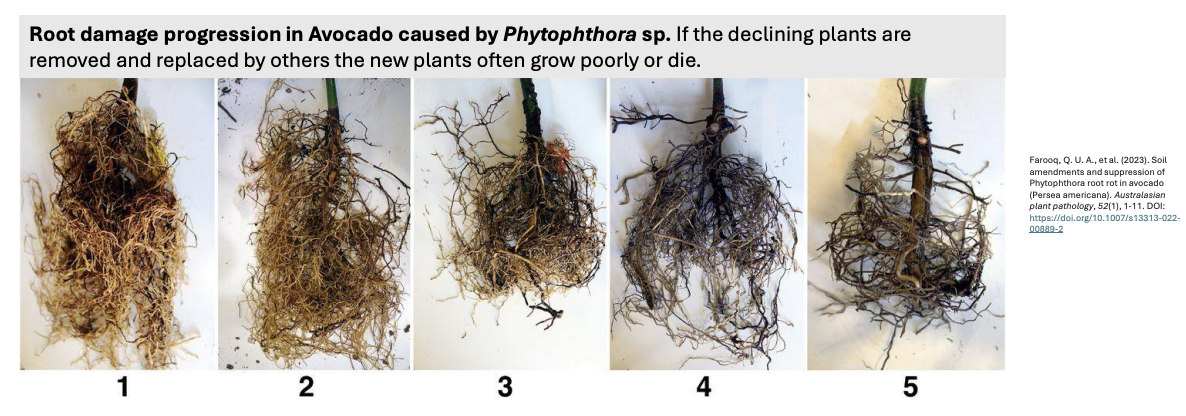
_ is one of the principal causes of decline in avocado orchards and also causes dieback disease of native eucalypt vegetation in Australia, raising concerns for the future of this unique assemblage of plant species
Phytophthora cinammomi
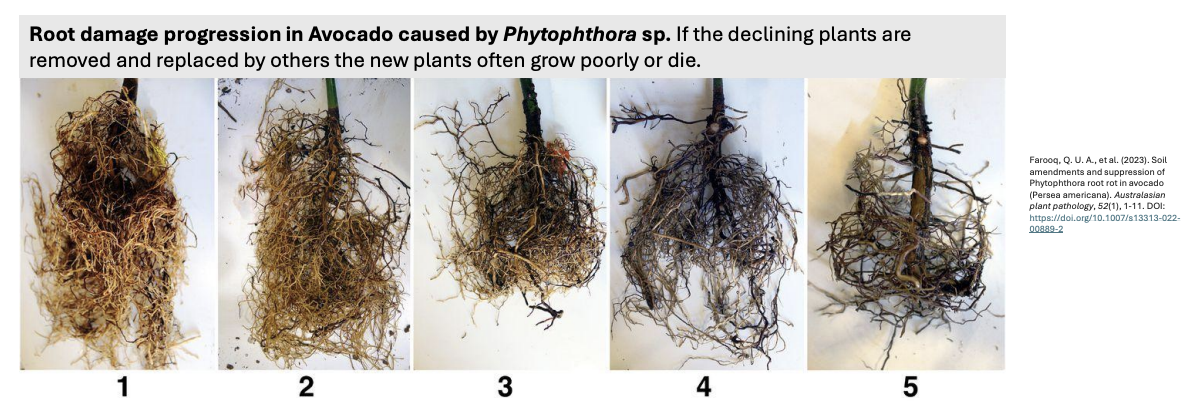
Explain necrotrophic decline & replant diseases
Some fungi can cause root decay that exceeds rate of root production, causing death
Root damage progression in Avocado caused by Phytophthora sp.
If the declining plants were removed and replaced by others, new plants often grow poorly or die
Hence, it’s important to do crop rotation!
Phytophthora cinnamomi is one of the principal causes of decline in avocado orchards and also causes dieback disease of native eucalypt vegetation in Australia, raising concerns for future of this unique assemblage of plant species
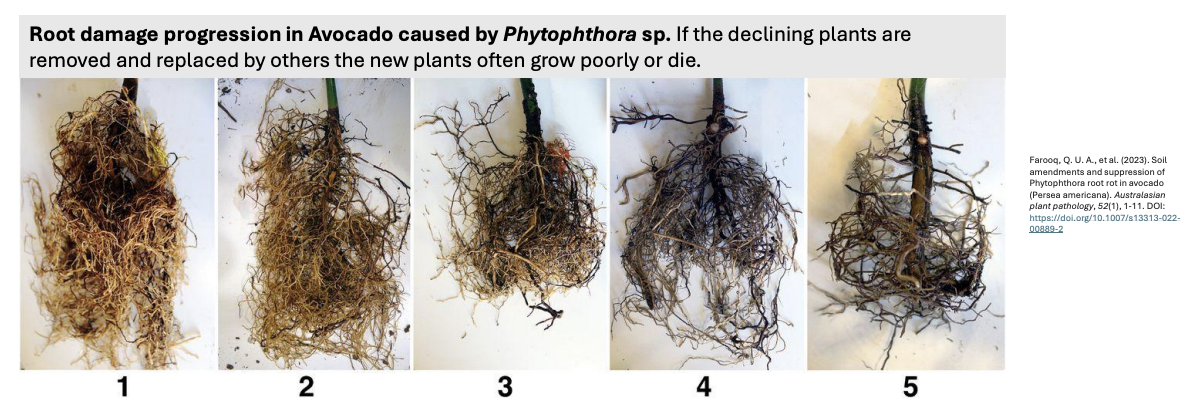
_ is a disease where new plants that replaced the removed declining plants still grow poorly or even die
Decline & replant disease
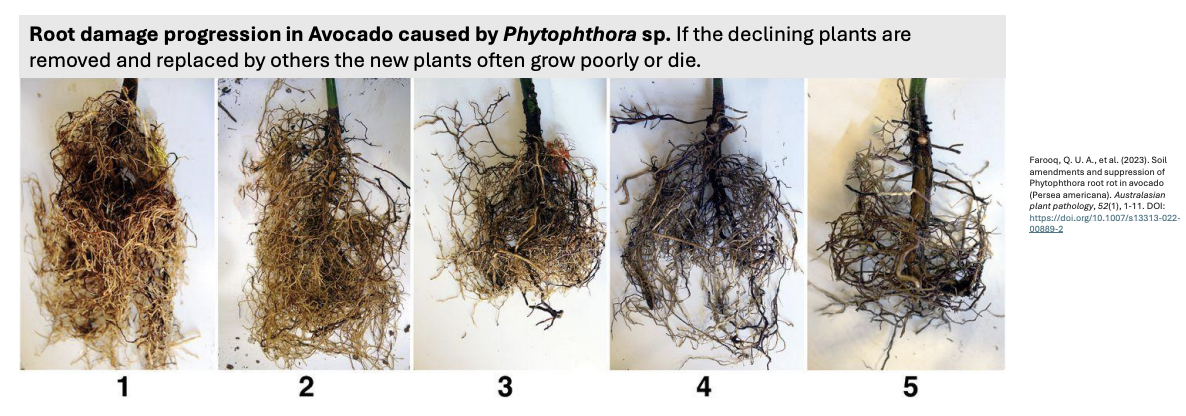
_ are characterized by fungi that damage seedlings and also grow on senescing plant tissues, exploiting the declining host resistance
Stalk rot pathogens
_ is a non-specialized stalk rot pathogenic fungus that attacks many crops, causing “charcoal rot”
Macrophomina phaseolina
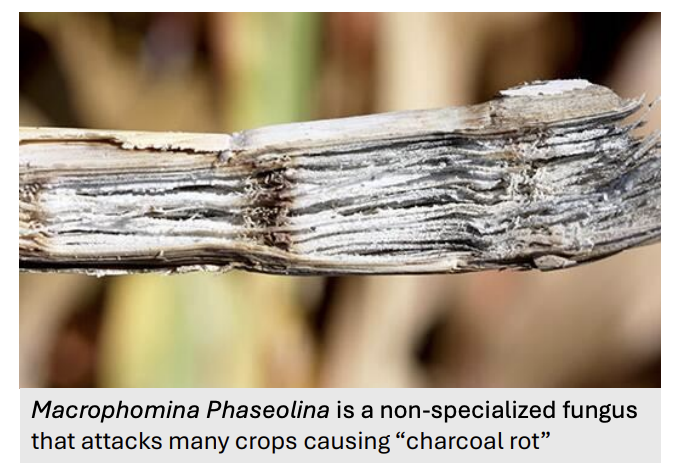
_ is a host-specialized stalk rot pathogenic fungus that infects maize, causing premature death
Gibberella zeae
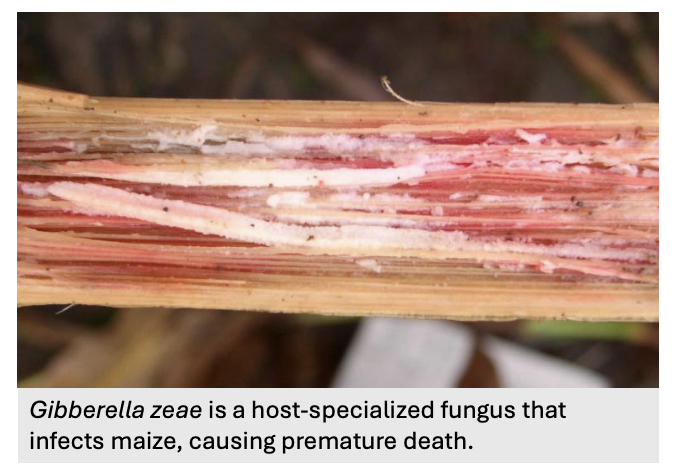
_ are fungi that respond to plant’s physiology and to stress conditions that predispose plants to infection; stress factors are many & varied, including tpmi temporary drought stress, poor light conditions (overcast weather), mineral nutrient deficiency, insect (stem-borer) damage
Stalk rot pathogens
Stalk rot pathogens are fungi that respond to plant’s physiology & stress conditions that predispose plants to infection; stress factors are many & varied, including _
tpmi
Temporary drought stress
Poor light conditions (overcast weather)
Mineral nutrient deficiency
Insect (stem-borer) damage
Explain necrotrophic stalk rot pathogens
Some fungi that damage seedlings also grow on senescing plant tissues, exploiting declining host resistance
e.g.,
Macrophomina phaseolina = non-specialized stalk rot fungus that attacks many crops, causing “charcoal rot”
Gibberella zeae = host-specialized fungus that infects maize, causing premature death
INFECT STEM (stalk tissue), thus preventing conducting of water upwards
Stalk rot pathogens respond to plant’s physiology & stress conditions that predispose plants to infection
Stress factors are many & varied, including tpmi
Temporary drought stress
Poor light conditions (overcast weather)
Mineral nutrient deficiency
Insect (stem-borer damage)
T/F: Stalk rot pathogens often infect dicots
FALSE
Stalk rot pathogens often infect monocots because these are the ones with stalk modifications in their stems
T/F: Stalk rot pathogens infect maize in roots
FALSE
Stalk rot pathogens infect maize in stem, thus they can no longer conduct water upwards
_ plants are often rotted by fungi
Ripening starch-rich, sugar-rich
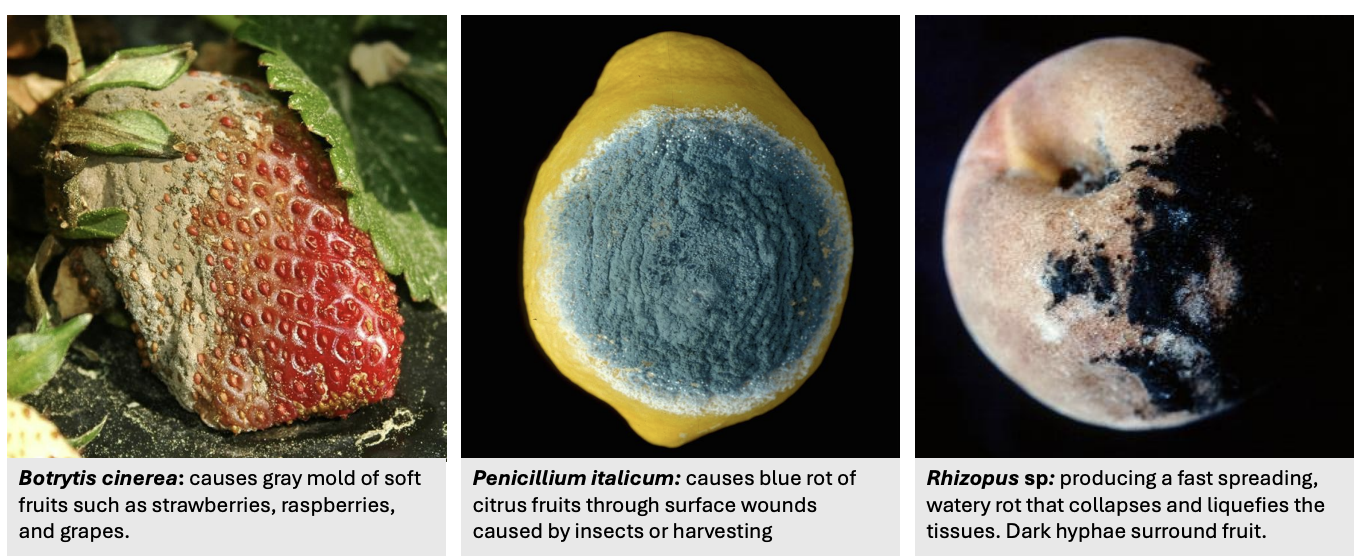
The common feature of all fruit-rot diseases is that _
the tissues are all rotted by pectic enzymes, which degrade middle lamella (cementing layer) between adjacent plant cell walls

_ is a fruit rot fungus that causes gray mold of soft fruits, including strawberries, raspberries, grapes srg
Botrytis cinerea
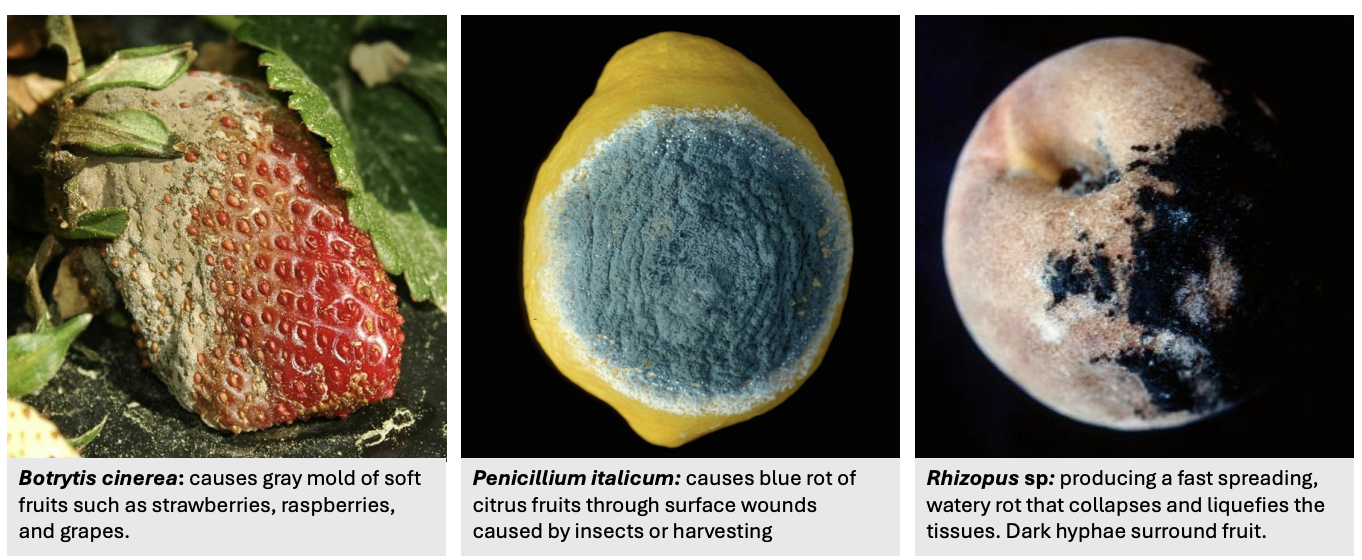
_ is a fruit rot fungus that causes blue rot of citrus fruits through surface wounds caused by insects or harvesting
Penicillium italicum

_ cause fast-spreading, watery rot that collapses and liquefies tissues; dark hyphae surrounds fruit
Rhizopus sp.
Explain necrotrophic fruit rot fungi
Ripening starch-rich, sugar-rich plants are often rotted by fungi
Botrytis cinerea = causes gray mold of soft fruits, e.g., strawberry, raspberry, grapes
Penicillium italicum = causes blue rot of citrus fruits through surface wounds caused by insects or harvesting
Rhizopus sp. = causes fast-spreading, watery rot that collapses & liquefies tissues; dark hyphae surrounds fruit
Common feature of all fruit-rot diseases is that the tissues are all rotted by pectic enzymes responsible for degrading middle lamella (cementing layer) between adjacent plant cell walls
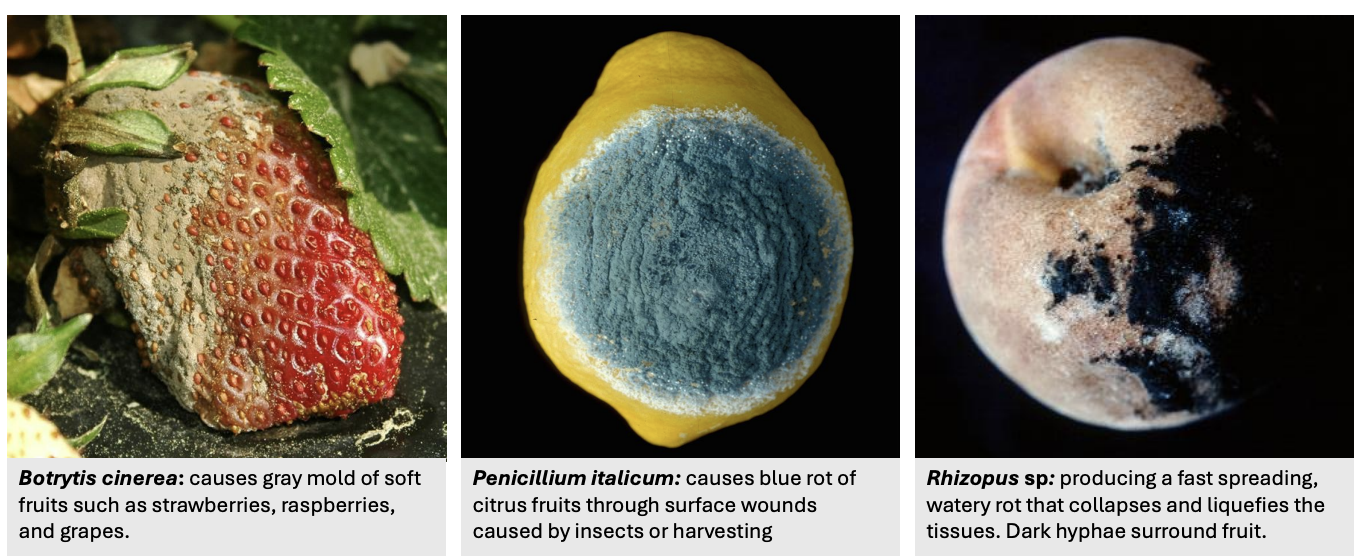
If the fungus has pectic enzymes, it can destroy middle lamella, causing _
cells to separate, make it easier for fungi to penetrate & feed on tissues
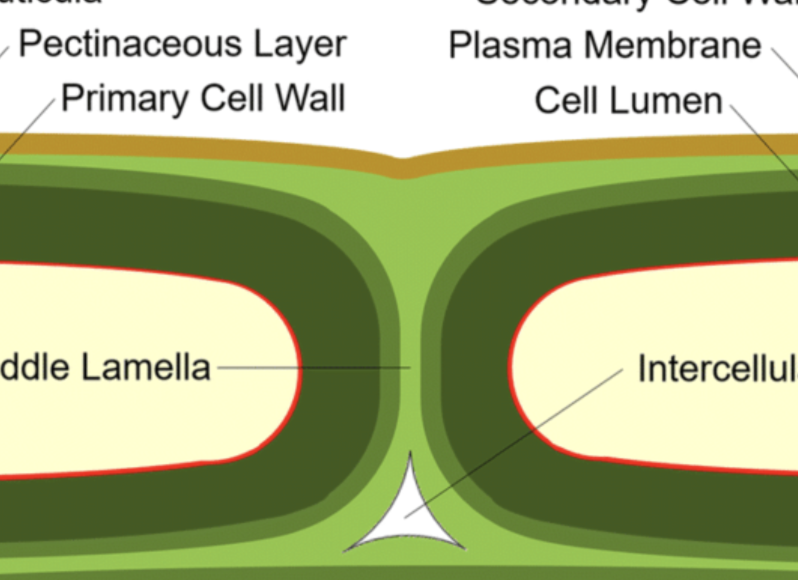
_ pass through xylem and cause devastating plant diseases
Vascular / vessel wilt pathogens
Vascular wilt fungi remain confined to nonliving xylem vessels until _
plant is heavily diseased, and only then do they invade living parenchyma cells
Explain vascular / vessel wilt diseases caused by Fusarium & Verticillium species
Spores enter the xylem through wounds, animal vectors, etc.
Spores then germinate within xylem & grow upward with the water flow
Xylems are empty at maturity; however, when this gets blocked by fungal hyphae > pipe can’t work, thus upper portion of plant dies
Spores hit vessel plates/perforation plates, hindering its motion, but then spores continue to grow and produce spores that traverse upwards
Plant responses
(3) Tylosis = initial response of plant to block flow
Balloon-like outgrowth from parenchyma cells that block xylem
(4) Gel extrusion through bordered pits to block lateral spore movement
(5) Secretion of phenolic compounds & phytoalexins (antimicrobials) that create toxic barriers to halt fungal progression
Vascular wilt pathogens remain confined to nonliving xylem until plant is heavily diseased, and only then do they enter living parenchyma cells
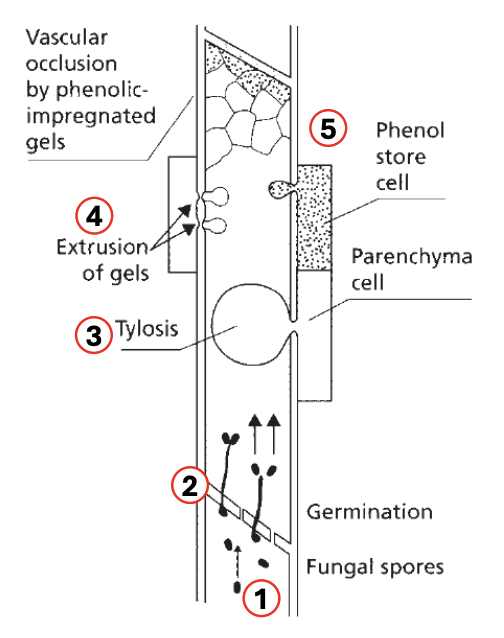
In any type of wilt disease, _ portion of plant should be looked at because it often shows earliest visible signs of vascular/xylem blockage
upper
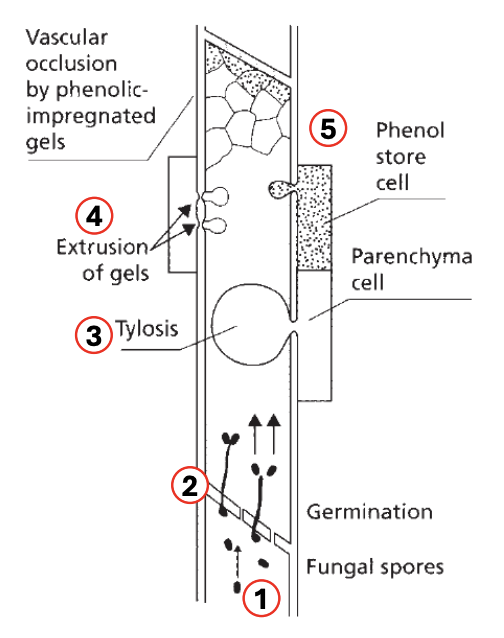
Fusarium oxysporum has _ strains that show specific pathogenicity to particular crop species
>80
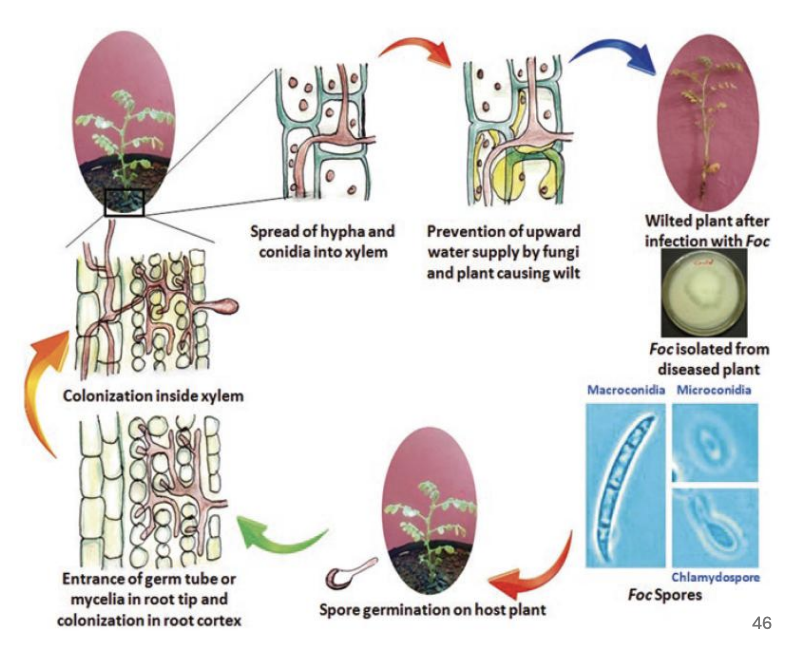
Genus Fusarium has up to _ species, several harmless, many are important pathogens
1000
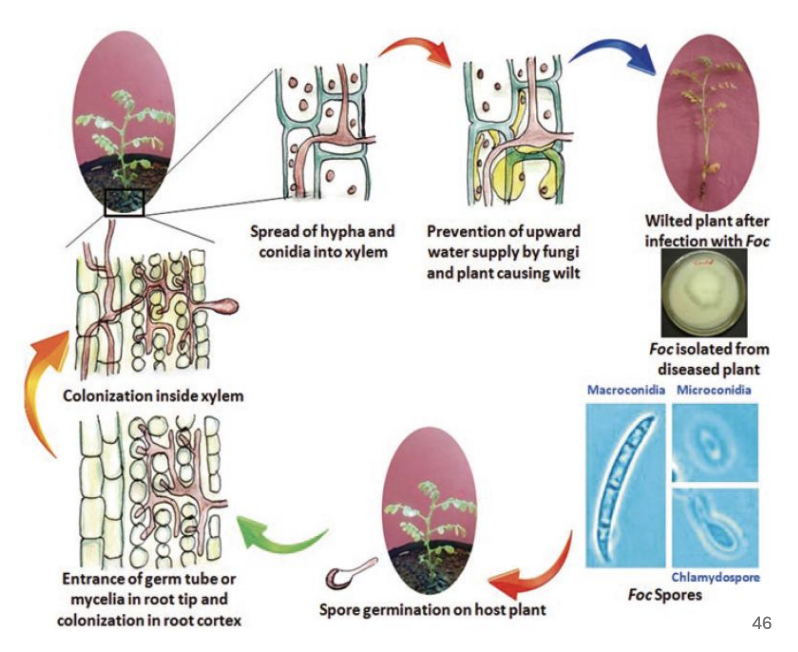
_ are spores derived from individual hyphal compartments by accumulating nutrients & developing thick, resistant cell wall; allows Fusarium to survive prolonged periods in soil & cause reinfection
Chlamydospores
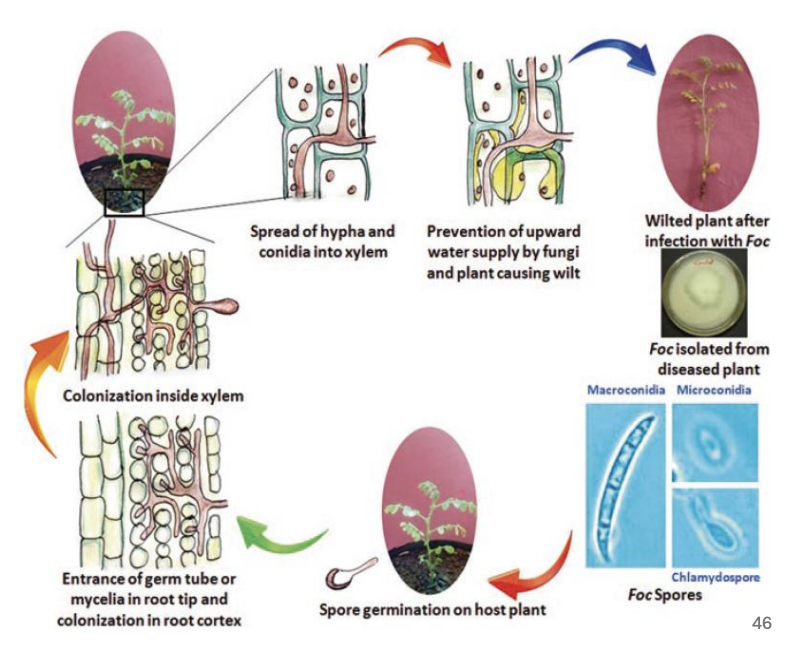
_ is a fungal plant pathogen that causes Panama banana disease or Fusarium banana wilt that already caused the loss of 1 banana cultivar (Gros Michel banana)
Fusarium oxysporum fsp. cubense (Foc)
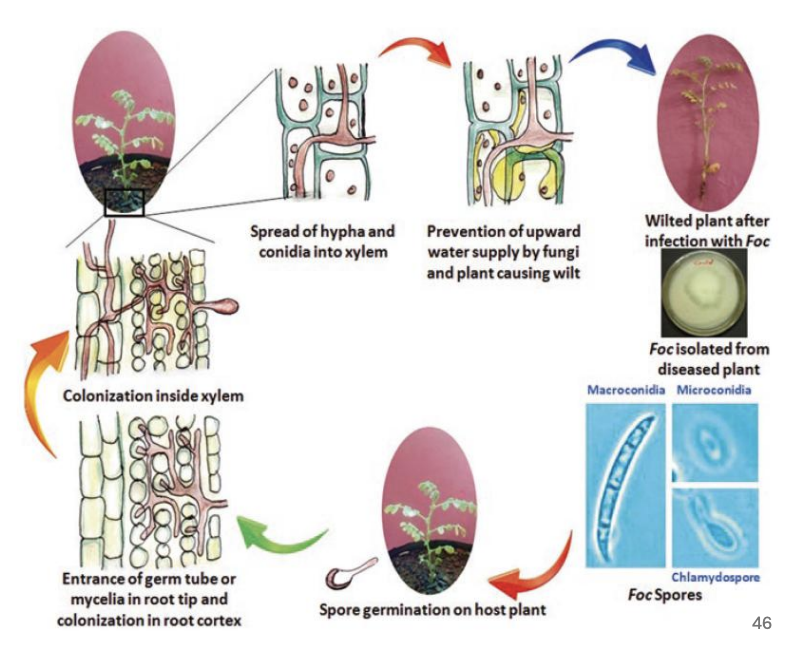
Explain vascular / vessel wilt disease caused by Fusarium
F. oxysporum has >80 strains that show specific pathogenicity to particular crop species
Genus Fusarium has up to 1000 species, several harmless, many important pathogens
Fusarium oxysporum fsp. cubense = fungal plant pathogen that causes Panama banana disease / Fusarium banana wilt that already caused the loss of 1 banana cultivar
Chlamydospores = spores derived from individual hyphal compartment by accumulating nutrients & developing thick resistant cell wall; allows Fusarium to survive for prolonged periods in soil & cause reinfection
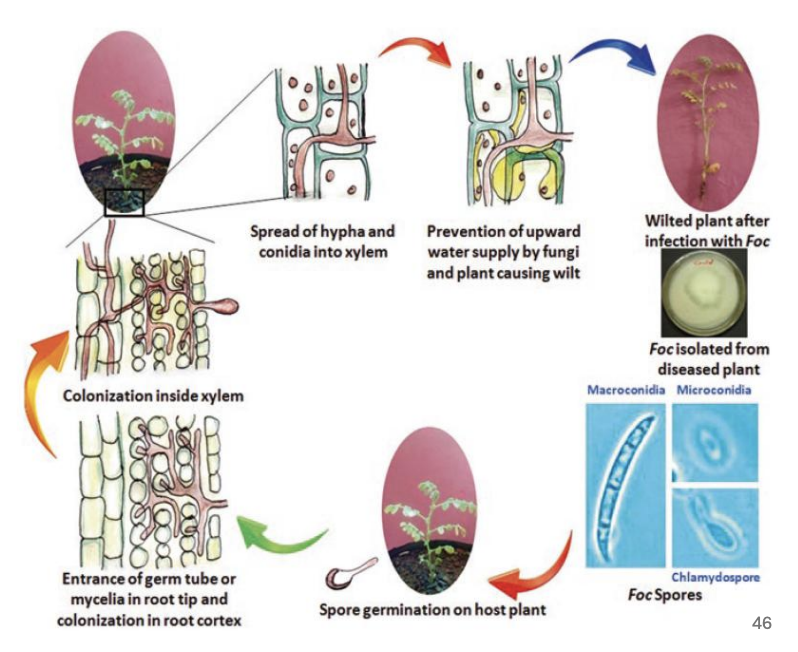
T/F: Fusarium causes the worst havoc in banana because it has the least amount of defenses to it compared to other plant species
TRUE
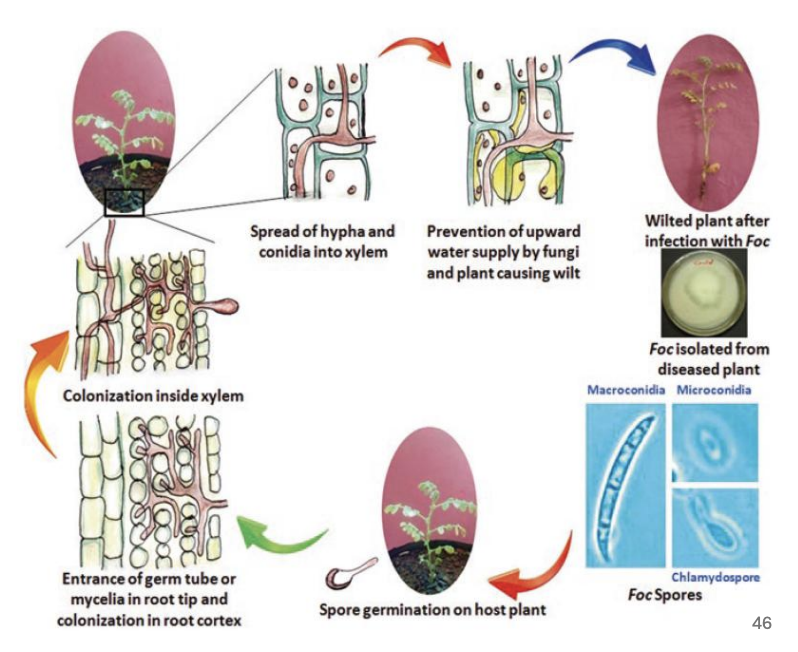
T/F: It is typically harder to kill a eukaryote than prokaryote
TRUE
Bc what can kill a eukaryote can kill other eukaryotes, thus you have to find antifungals specific to Fusarium chlamydospores
What’s the issue with using biocontrol agents to eliminate Fusarium chlamydospores?
It’s the endemicity because one must know the effects of biocontrol agent not only to Fusarium but also to other fungal associations present in plant and environment in general
For instance, something that’s likely to eliminate Fusarium chlamydospores can also affect other fungal associations of plant, which could be beneficial to plant growth and thus still negatively affect the plant

Explain infection process that cause vessel wilt disease by Fusarium
Fungal spores land on plant & begin to germinate
Germ tube or mycelium enters root tip & colonizes root cortex
Colonize inside xylem
Spread of hypha & conidia within xylem then
prevents upward water supply by fungi, causing plant to wilt
Wilted plant after Foc infection
Foc spores = macroconidia, microconidia, chlamydospores; many forms allow them to effectively adapt to plant defenses & persist in environment
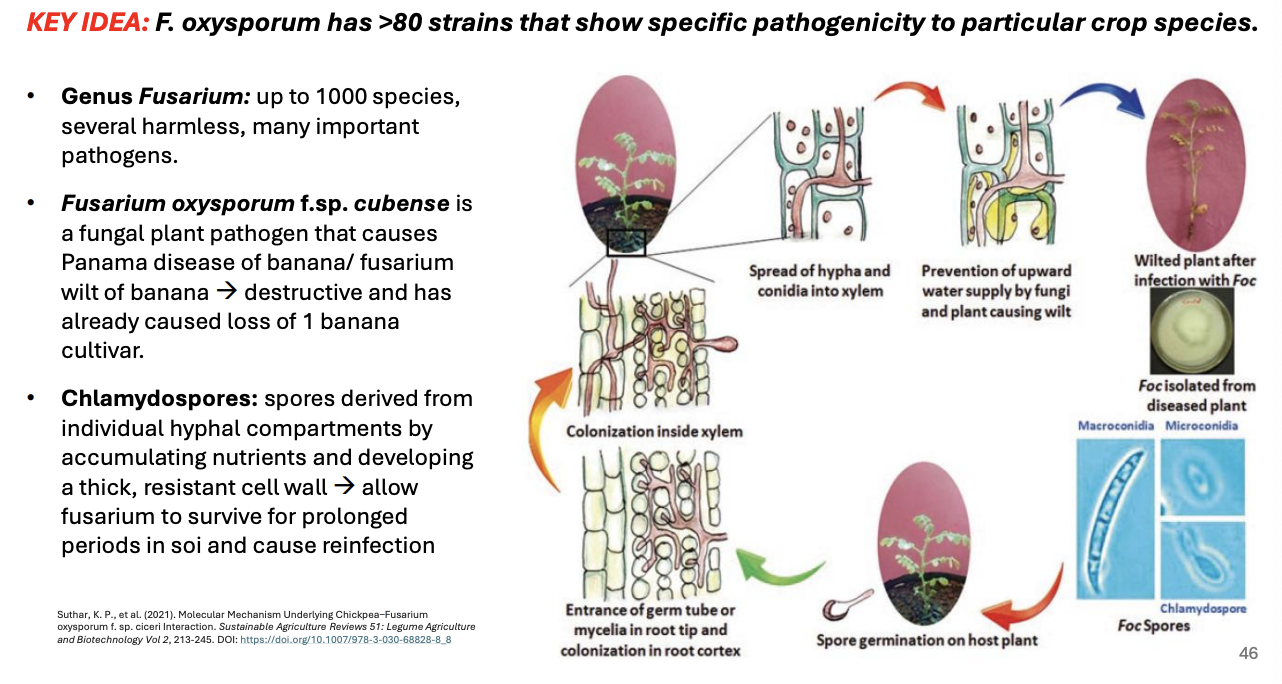
T/F: Fusarium oxysporum f.sp. cubense infects a wide variety of crops, including bananas, tomatoes, and chickpeas
FALSE
F. oxysporum f.sp. cubense is specific to bananas. Other formae speciales target other crops
_ are basidiomycetes that affect economically significant grains
Smuts
Explain necrotrophic smut fungi
Smut fungi = produce sooty black teliospores; mycelial tumor
Over 1000 species
Ustilago nuda (loose smut of wheat)
Ustilago maydis (maize smut)
Tilletia caries (stinking smut of wheat)
Spore penetration = germinating spores penetrate ovary; resulting seeds carry mycelium
Life cycle
Mature mycelial tumor
Teliospore dispersal
Germinating teliospores
Haploid cell
Conjugate tube formation
Dikaryotic filament
Form appressorium & penetrate plant
Dikaryotic mycelia growing thru & between plant cells
Karyogamy & fragmentation
Teliospore formation
Tumor initiation
→ Mature mycelial tumors

T/F: Smut fungi is a necrotrophic generalist (non-specialized) and thus can attack any starchy and grainy plant part
TRUE
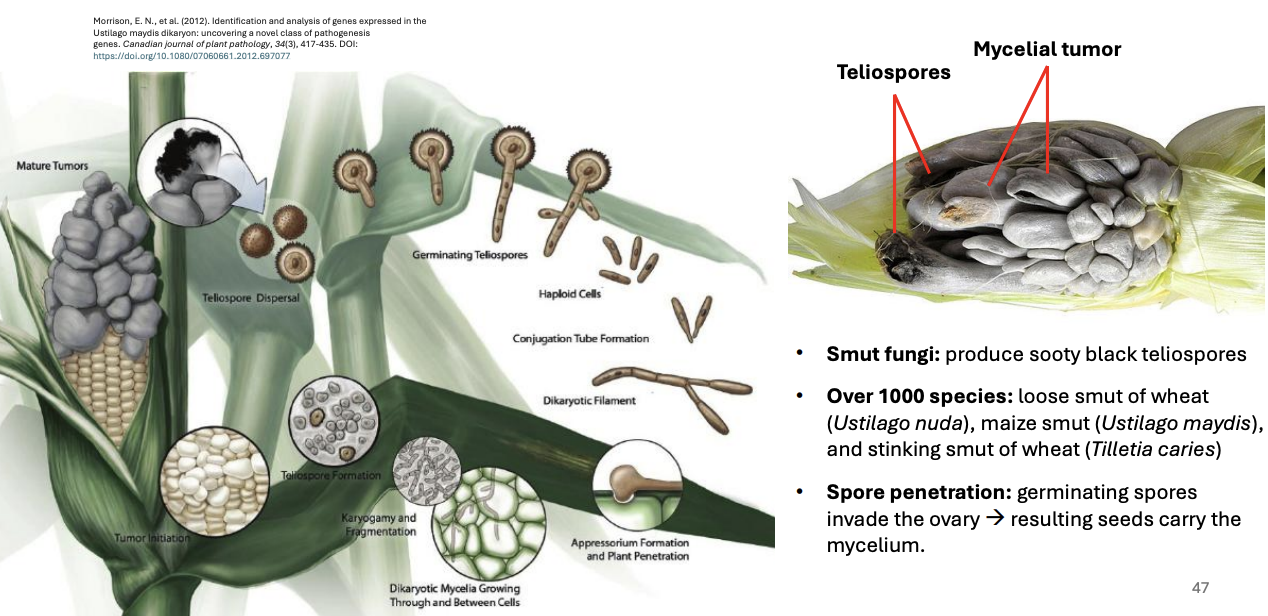
T/F: Mycotoxic endophytes, e.g., Neotyphodium, can cause mycosis
FALSE
Neotyphodium endophyte do not cause “mycosis” bc they do not infect the animal but just produce secondary metabolites that when consumed by animals can kill them
Endophytes can cause animal death through _
secondary metabolite production
Explain necrotrophic mycotoxic endophytes
Effect depends on size of animals; larger ones need to consume more of secondary metabolites to be affected because of distribution of chemicals; smaller = more susceptible
Neotyphodium fungal endophyte in ryegrass (Lolium sp.) can produce secondary metabolites, including
Ergovaline = fescue foot toxicosis; inability to gain weight, stillbirth, tissue necrosis > can’t walk > can’t eat > dies
Lolitrem B = potent neurotoxic agent that can cause ryegrass stagger in animals
Peramine = potent invertebrate poison; small amounts can be lethal
Peramine poisoning
Mildly toxic to humans = burning sensation, temporary paralysis
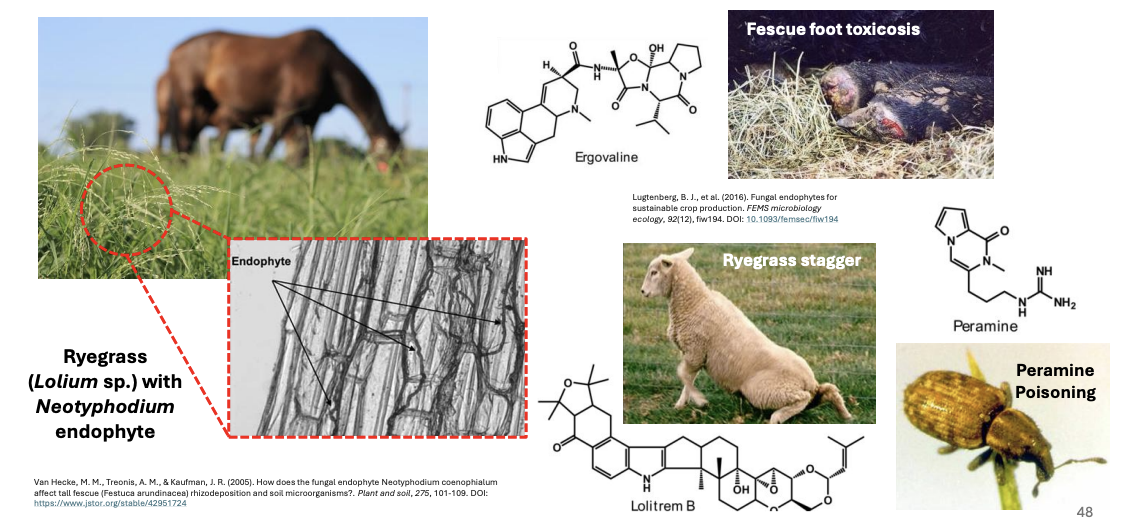
T/F: Mycotoxic endophytes are triggered to produce toxic secondary metabolites when their host is threatened by herbivory
TRUE
Genus Phytophthora has _ described species that are almost all pathogenic
> 50 described species
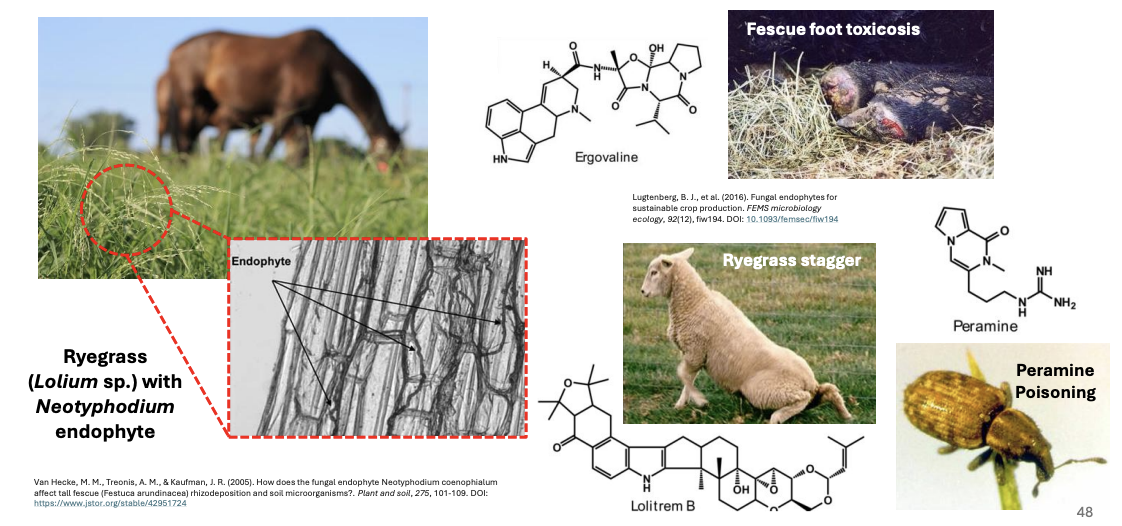
Explain necrotrophic Phytophthora (not true fungi)
Phytophthora oomycetes can cause several diseases in important plant species
Genus Phytophthora has >50 described species almost all are pathogenic
Several impacts
Root rots = avocado, eucalyptus
Canker = oak trees
Collar & crown rots = tomato, cucumber, watermelon, squash
Aerial blights = poinsettias
Fruit rots = peppers, papaya, citrus
Phytophthora infestans = great potato blight
Phytophthora sojae life cycle
Oospores germinate & produce sporangia, which release zoospores at ≥ 60F in saturated soils
Oospores & zoospores infect plant roots
Characteristic disease symptoms dysb damping off, yellowing, stunting, brown lesions on lower stem
Pathogen overwinters as oospores formed in crop residues
Oospores germinating again, producing sporangia that release zoospores
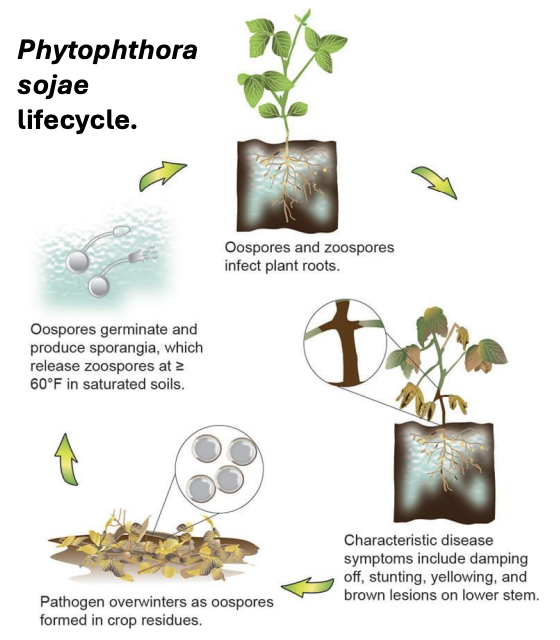
_ generate infection structures to access host cytoplasm via growth of haustorium
Biotrophic fungi

Enumerate 3 major haustorial biotrophic groups
rpd
Rusts
Powdery mildew
Downy mildew
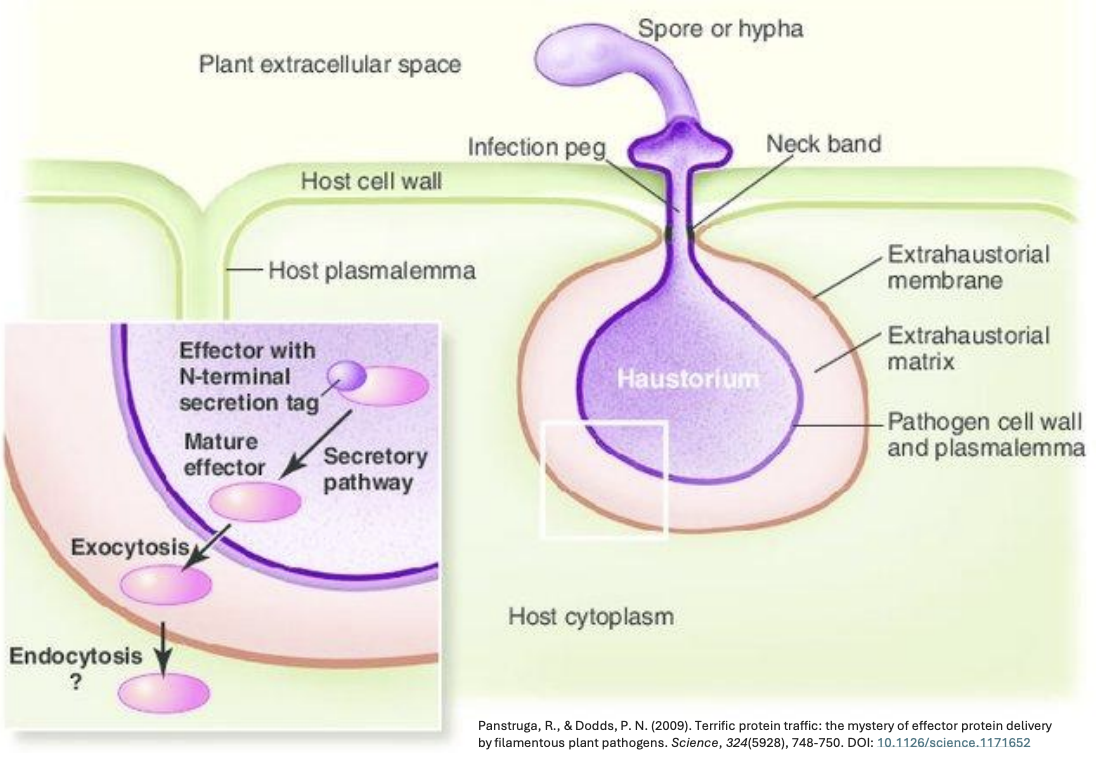
Explain general mechanism of haustorial biotrophs
Spore/hypha of mycoparasites form an infection peg to penetrate host cell wall
Forms haustorium inside host cell but outside host cytoplasm; surrounded by extrahaustorial membrane + matrix
Neck band seals haustorium, allows tight control of nutrient flow
Secretion of effector molecules (via secretory pathway > exocytosis from haustorium > endocytosis? into host cytoplasm) from haustorium is thought to contribute to:
Ability to avoid eliciting host cell death
A means to secure continuous nutrient supply from living host tissues
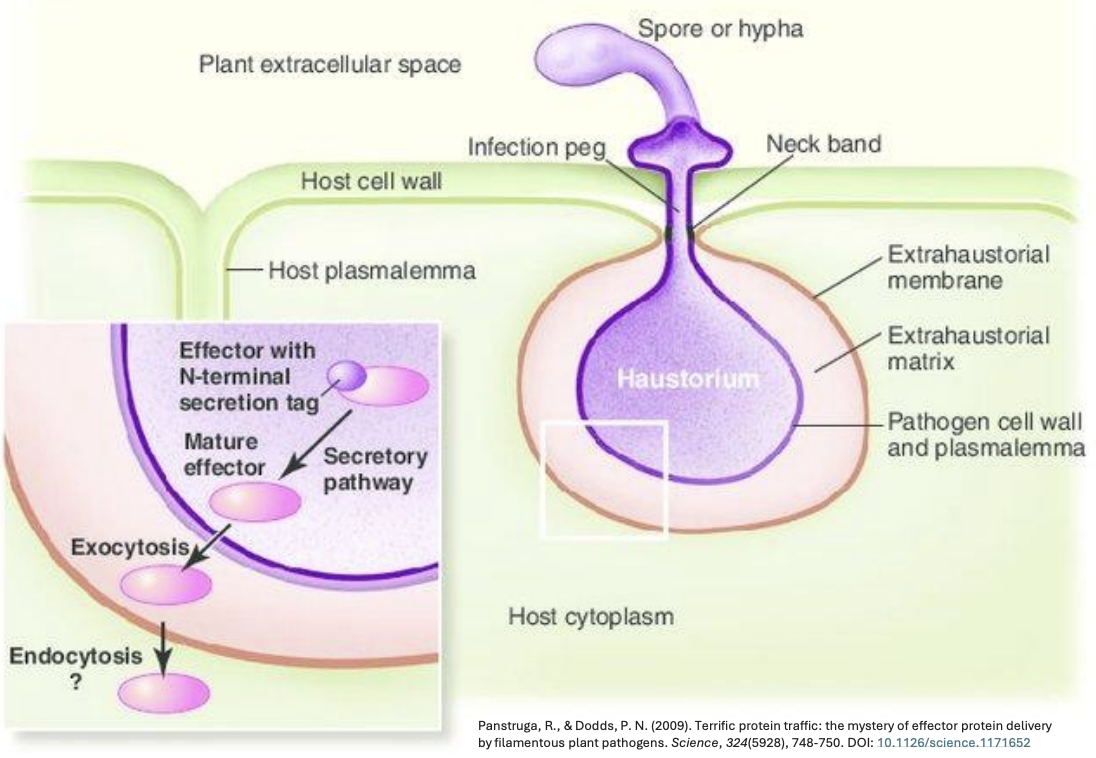
_ are obligate parasites that afflict wide range of plants and poses serious threats to cropping systems & global food security
Rust fungi
Explain rust fungi as haustorial biotrophs
Rust fungi = obligate parasites afflicting a wide range of plants; pose serious threats to cropping system & global food security
Massive uredospore production in advanced stages of stripe rust disease on wheat seedlings
Disease cycle of Puccinia graminis, alternating growth on wheat & barberry
Aeciospores, Uredospores (diploid), Teliospores aut → wheat
Teliospores undergo nuclear fusion & meiosis → haploid basidiospores → barberry
Key idea: 1 fungus can infect multiple plant species in 1 life cycle (bc it can produce multiple types of spores in 1 life cycle)
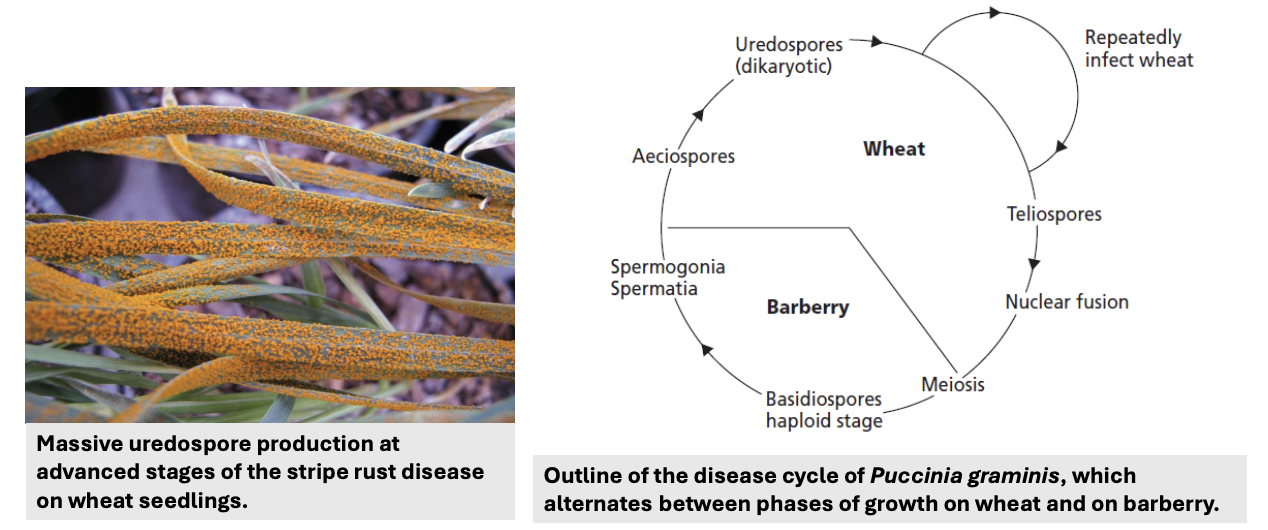
_ can cause significant epidemics in most seasons when not treated with fungicides
Powdery mildew
T/F: Powdery mildews appear as spores or patches of white to greyish talcum-powder-like growth, which are severe in cold, dry climates
FALSE
Powdery mildews appear as spores or patches of white to greyish talcum-powder-like growth, which are severe in warm, dry climates
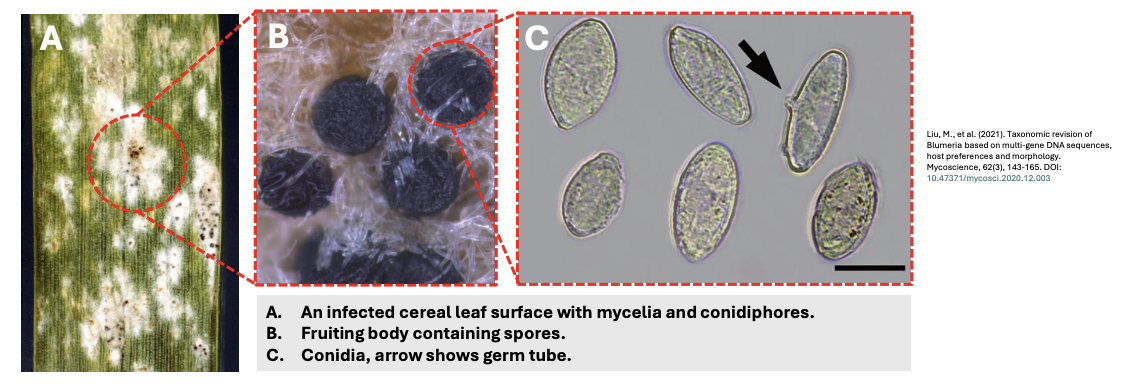
_ is the most damaging powdery mildew species, causing powdery mildew of cereals and affecting roots & shoot
Blumeria graminis
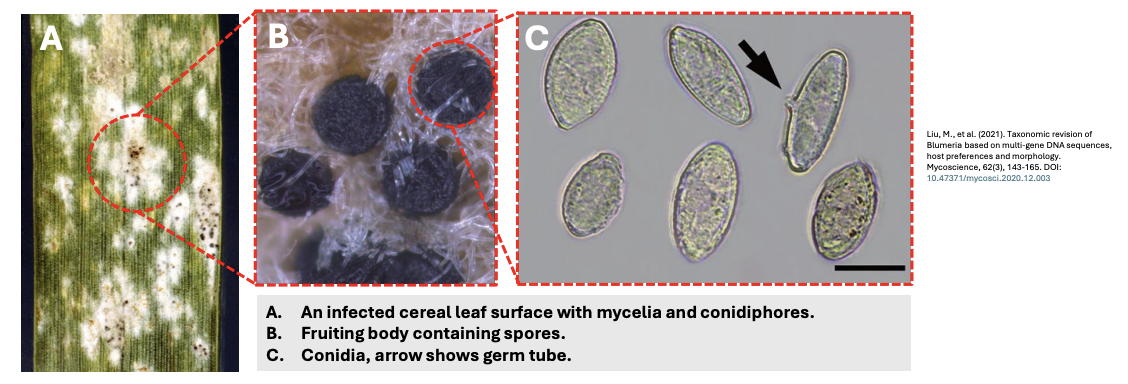
Explain powdery mildew as haustorial biotrophs
Powdery mildews can cause significant epidemics in most seasons when not treated with fungicides
(A) Infected cereal leaf surface with mycelia & conidiophores
(B) Fruiting body containing spores
(C) Conidia with growing germ tube
Powdery mildew appears as spores or patches of white to greyish talcum-powder-like growth which are severe in warm, dry climates
Can survive a lot of antagonism, hence the need to be treated with fungicides!
Blumeria graminis = most damaging, causes powdery mildew of cereals, affecting root & shoot
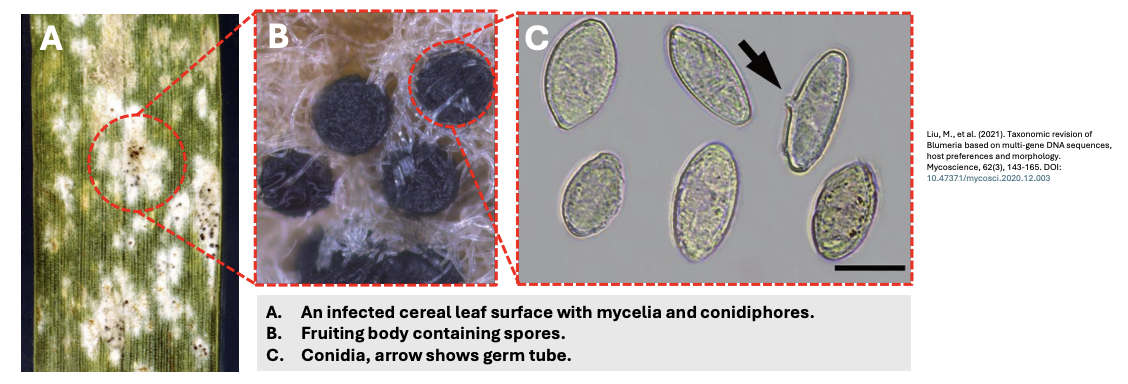
T/F: Major difference between powdery and downy mildews is that downy mildews are not usually white and could have wider range of colors
TRUE
Pink, rust-colored, white, etc.
T/F: Downy mildews are less distributed than powdery
TRUE
Powdery mildews can survive in tropics, temperate
Downy = high humidity areas
_ are like rust fungi (basidio-) and powdery mildews (asco-) but are not true fungi but instead from _ and require _ for infection & sporulation
Downy mildews
Oomycota
humid conditions

Fruiting structures of downy mildews emerge from _ and create _ coating
Underside of leaves
Variably-colored, downy

Explain downy mildew as haustorial biotrophs
Downy mildews are like rust (basidio) and powdery mildews (asco) but are from Oomycota and require humid conditions for infection & sporulation
Fruiting structures emerge from underside of leaves & create variably-colored, downy coating
e.g.,
(A) Bremia lactucae (lettuce)
(B) Plasmopara viticola (grapevines)
(C) Pseudoperonospora humuli (hops)

Fungi commonly attack _ in natural environments, acting as natural population regulators
insects, nematodes, & other invertebrates

Invertebrate fungal parasites can be categorized as _ depending on their antagonistic behavior
Endophytes = live inside host body hcb
Chytridiomycota
Catenaria anguillulae (zoospore)
Oomycota
Myzocytium humicola (adhesive zoospore cyst)
Asco
Harposporium anguillulae (non-adhesive conidia)
Asco
Beauveria bassiana (conidia)
Predatory = derive some or most nutrients from trapping & eating microscopic or other minute animals sapo
Zoopago = Stylopage sp. (adhesive hyphae)
Asco = Arthrobotrys dactyloides (constricting hyphae)
Basidio = Pleurotus tuber regium (adhesive traps & toxic droplets)
Other nematophagous traps
Opportunistic = parasitize host cyst & eggs (mostly worms)
Ascomycota: Pochonia chlamydosporia (hyphal invasion)
Ascomycota: Hyalorbilia oviparasitica (conidia)
T/F: There is a great diversity of fungal parasitic behaviors using different types of infective units
TRUE
T/F: Beauveria bassiana is a parasitic fungus that can infect almost all invertebrates, while Coelomomyces spp. infect mosquitos & midges, often host-specific
TRUE
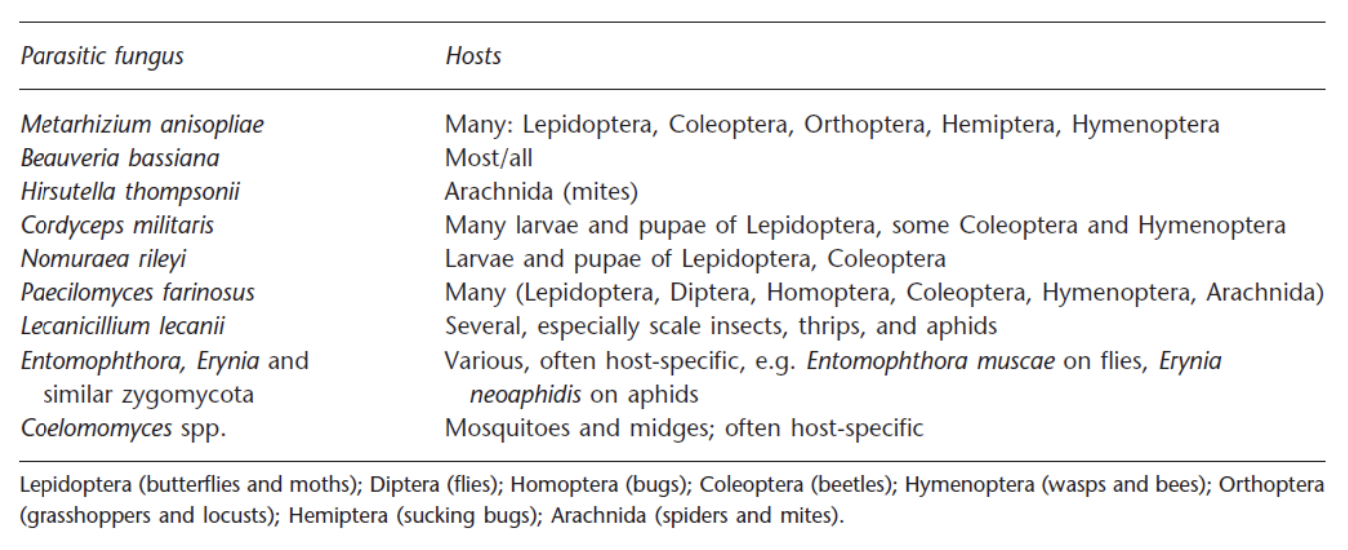
Explain general infection sequence of fungal endoparasites
dgap pitp dsard
Dispersal spore lands on cuticle
Germinates
Forms an appressorium
Penetrate cuticle
Proliferate on cuticle
Invade epidermis & hypodermis
Tissue invasion by normal hyphae
Proliferate hyphal bodies or yeast-like cells in hemolymph (invertebrate circulatory system)
Insect death
Saprotrophic growth
Asexual / sexual resting stage
→ ? Asexual dispersal spores
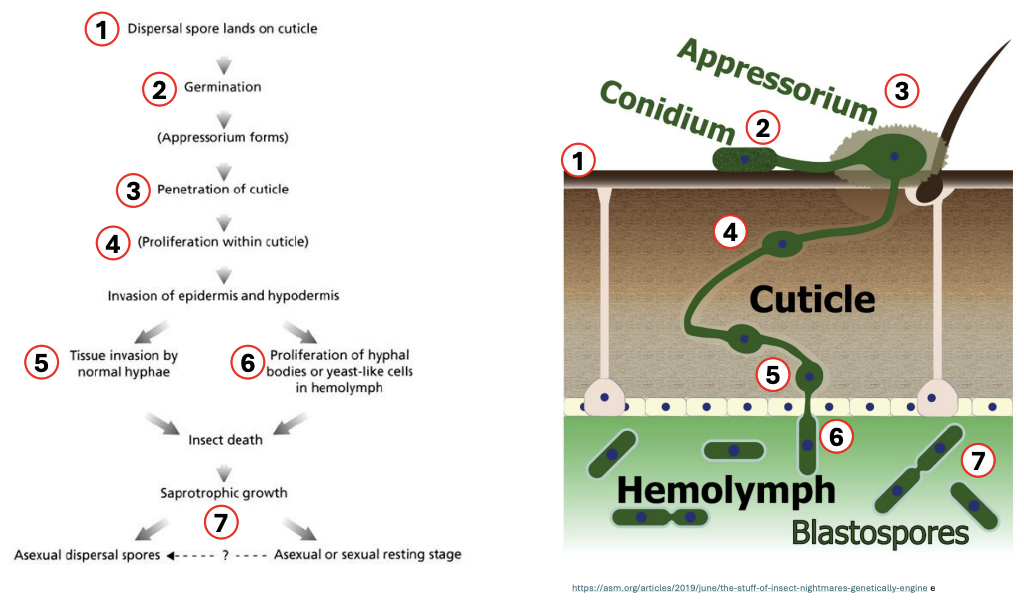
_ is an endoparasitic fungi that initiates infection as spores that adhere to nematode surface and germinates to infect host
Harposporium anguillulae (asco)
Explain Harposporium anguillulae (asco) as invertebrate endoparasite
Endoparasitic fungi initiating infection as spores adhering to nematode surface, then germinates to infect host
(A) Staged interaction / co-culture of H. anguillulae & P. redivivus nematode
(B) Hyphal growth thru nematode body
(C,D) Increased hyphal extrusion thru body wall
(E, F) Nematode body has been been completely colonized by hyphae; lysed > feed on contents
(G) H. rhossiliensis with hyphae growing & producing conidia
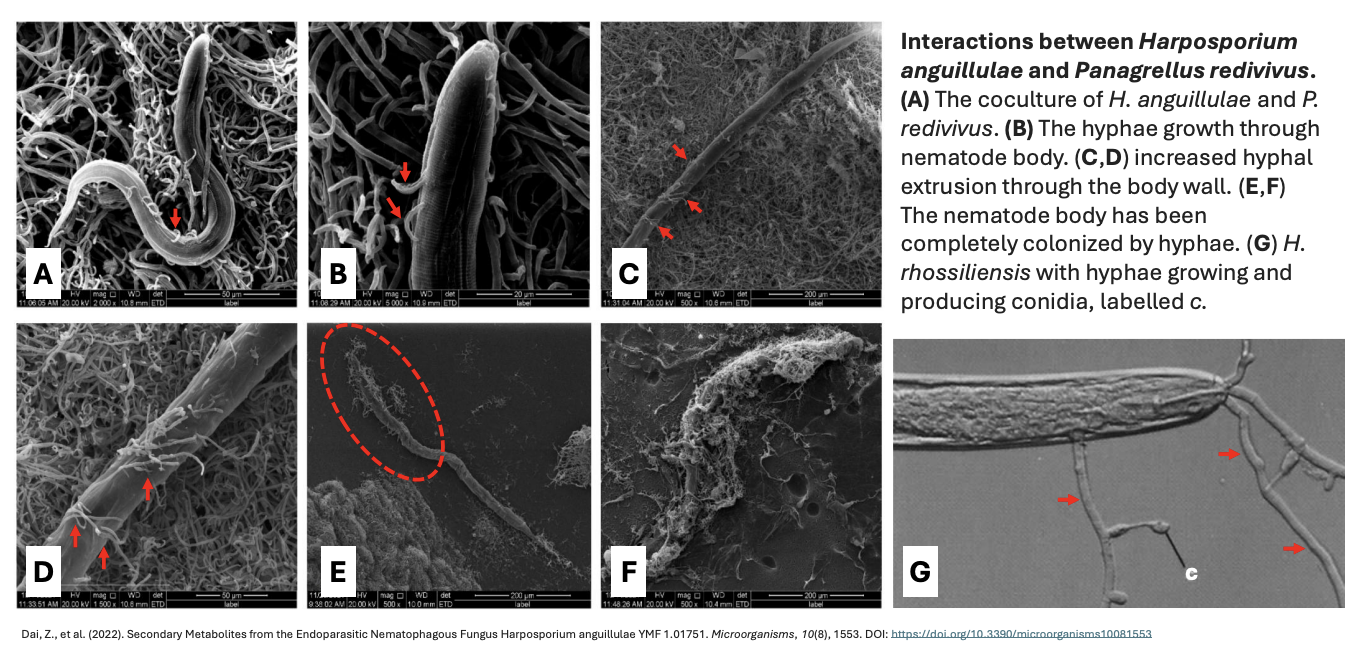
_ is a facultative, non-specialized chytrid model parasite of nematodes, eggs of liver flukes, & other small invertebrate organisms
Catenaria anguillulae
Explain Catenaria anguillulae as invertebrate endoparasite
Catenaria anguillulae = chytrid that infects many invertebrates using zoospores via chemotaxis
Facultative, non-specialized chytrid model parasite of nematodes, eggs of liver flukes, other small invertebrate orgs
(A) 5 zoospores are attracted to bulb region of nematode where excretory pore discharges compounds that causes zoospores chemotaxis
(B) Several zoospores were attracted to tail region of nematode, near anal pore
They encysted & produced vesicles & rhizoids, many of which are inside animal body
Vesicles will become sporangia whose contents will be cleaved to produce zoospores, which will be released to repeat infection cycle

_ is an insect fungal parasite that can thrive on plant host commensally or mutually but can be parasitic to its insect targets
Beauveria bassiana (asco)
Explain Beauveria bassiana (asco) as invertebrate endoparasite
(A) B. bassiana is fungal endophyte thriving on plant host without harming it (commensal/mutual) but can be (B) parasitic to insects that consume their plant host, as evidenced by its effects on pecan weevil larvae
(C,D) It affects various insects, e.g., Tenebrio molitor, Rhynchophorus ferrugineus
It is able to do this because has conidia that grows &
(1) uses several enzymes that degrade tissue structure: chitinases, proteases, lipases cpl
(2) it produces insecticidal substances: oosporein, beauvericin, beauverolides, tenellin, obbt which either suppress immunocytes or directly destroy insect hemolymph

_ is a predatory invertebrate parasite that subsists on various amoeba or nematodes by trapping their prey
Stylopage sp. (zoopago)
Explain Stylopage sp. as predatory invertebrate parasite
Stylopage sp. (zoopago) subsist on various nematodes / amoeba by trapping them
All 17 Stylopage species infect various amoeba or nematode species by
spores can stick on body and germinate inside or
trapping them using adhesive substances that coat their vegetative hyphae and then
absorbing nutrients through haustorium projection
(a) Stylophage hadra conidiophore
(b,c) Hypha with captured nematode, showing assimilative branch inside nematode body
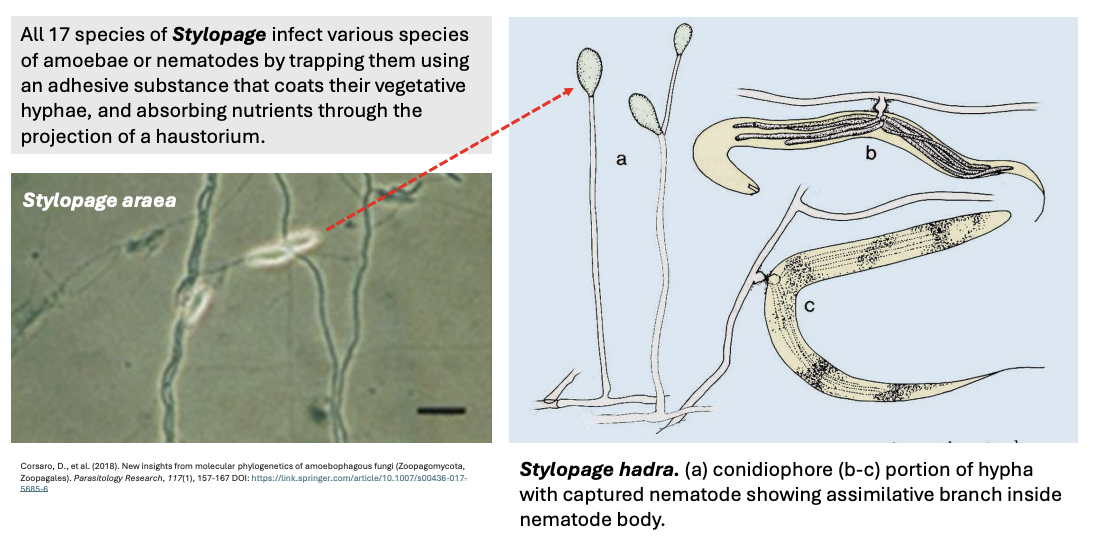
_ is a predatory invertebrate parasite that create constricting rings using its hyphae
Arthrobotrys dactyloides (asco)
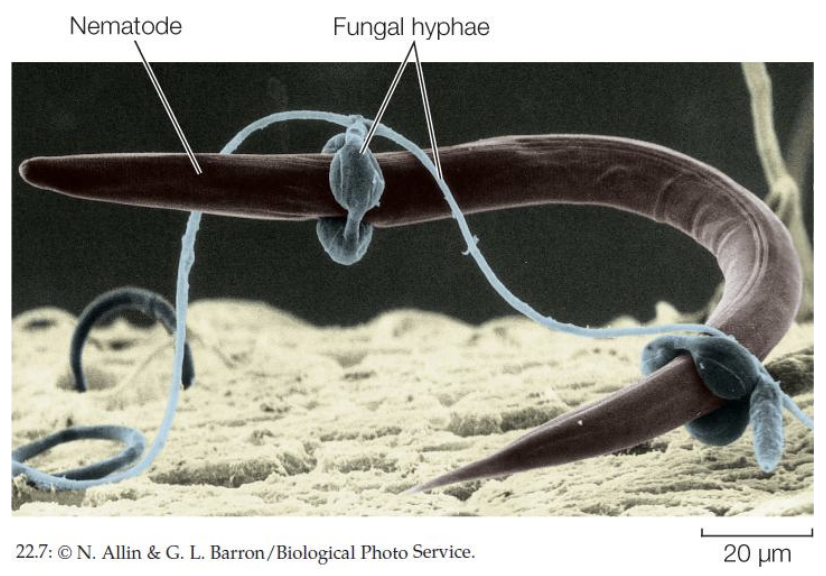
Explain Arthrobotrys dactyloides (asco) as predatory invertebrate parasite
Arthrobotrys dactyloides (asco-) can form hyphal rings that constrict sharply and catch nematode in loop
Nematode motion in loop or by heat/pressure can trigger/cause 3 cells in loop to inflate suddenly, thus trapping nematode
Branches of hypha invade on either side of loop and digest & absorb soft tissues
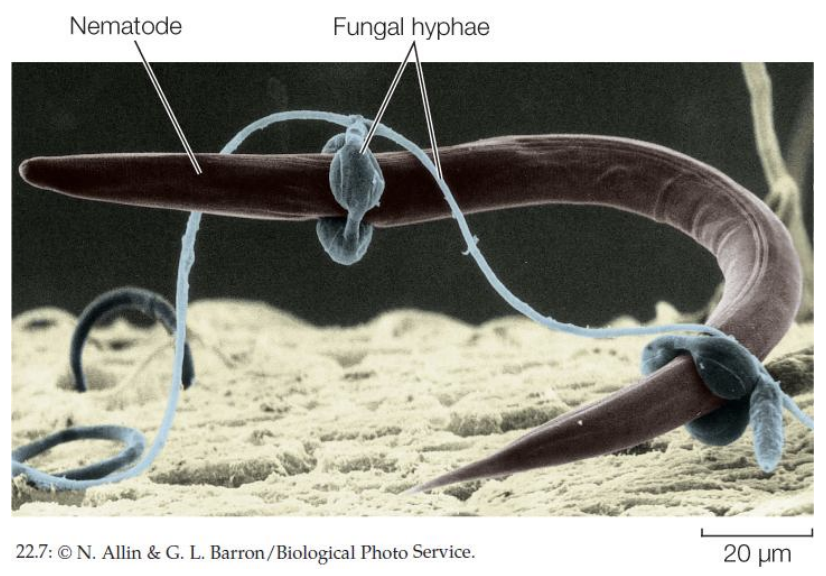
_ is a predatory invertebrate parasite that produces toxic droplets that allow hyphal colonization
Pleurotus tuber regium (basidio)

Explain Pleurotus tuber regium as predatory invertebrate parasite
Pleurotus tuber regium (basidio) produces toxin droplets that allow hyphal colonization
Nematode-trapping structures of Pleurotus tuber regium
When droplets encounter enough motion from worm, they pop and contact with droplets cause paralysis
(1,2) Toxin droplets on aerial hyphae
(3) Disrupted extracellular toxin droplet
(4) Healthy nematode (sharpened end)
(5) Paralyzed nematode by contact with toxin droplet, indicated by blunted nematode head
Once paralyzed, hyphae then penetrate worm and absorb nutrients
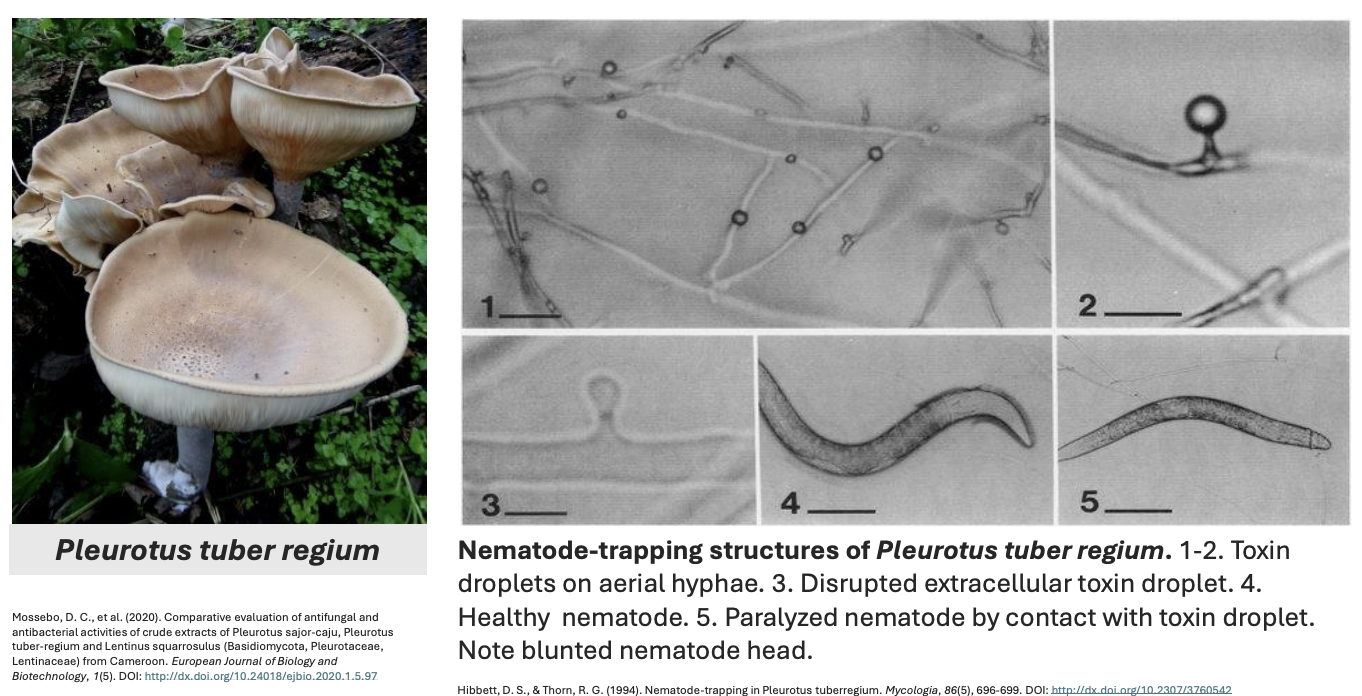
T/F: Pleurotus tuber regium are acclimated to respond only to pressure from worm swimming or touching it
TRUE
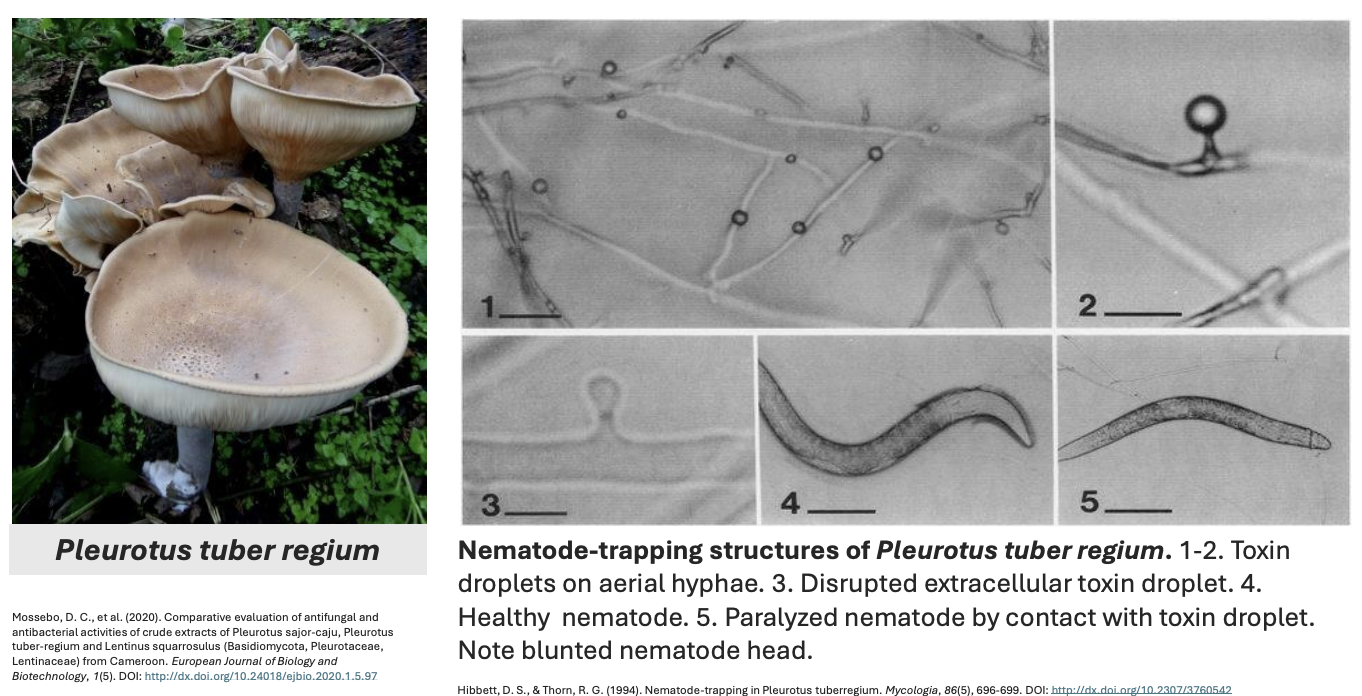
_ use several traps to target Nematodes (roundworm) as their prey, e.g., adhesive conidia, columns, & knobs acck
Nematophagous fungi
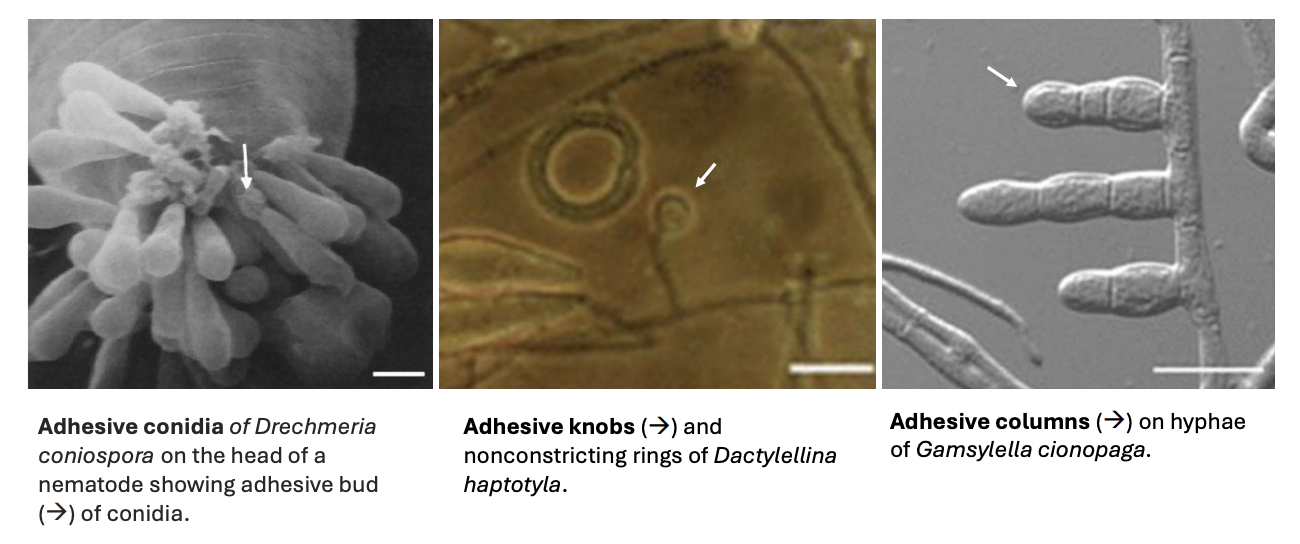
_ is a nematophagous fungi that utilizes adhesive bud of conidia to trap nematodes
Drechmeria coniospora
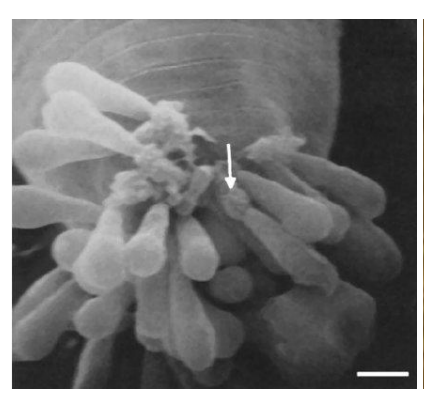
_ is a nematophagous fungi that utilizes adhesive column on hyphae to trap nematodes
Gamsylella cionopaga
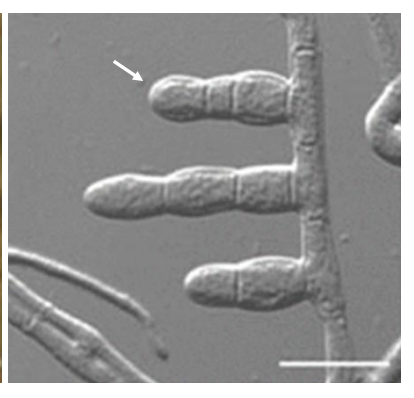
_ is a nematophagous fungi that utilizes adhesive knob & nonconstricting rings to trap nematodes
Dactylellina haptotyla
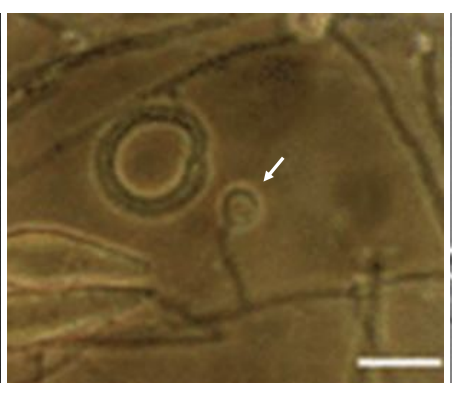
_ are important for controlling hard-to-kill nematodes
Cyst & egg opportunistic fungal parasites
e.g., Pochonia chlamydosporia, Paecilomyces lilacinus (both asco-) on M. javanica eggs